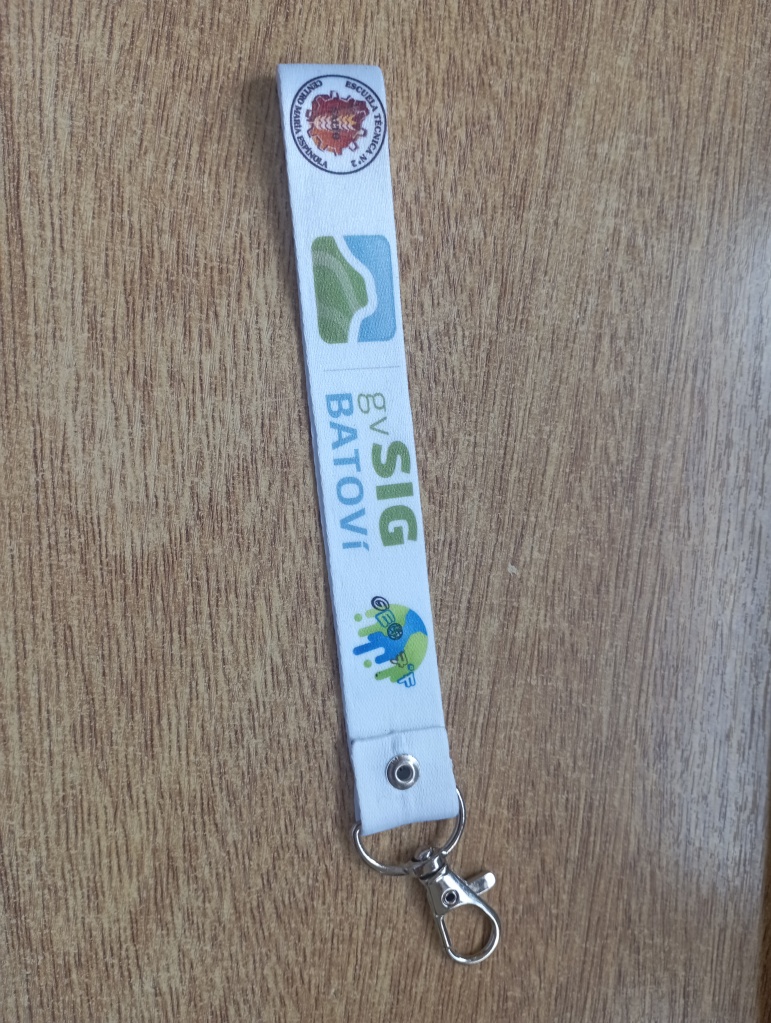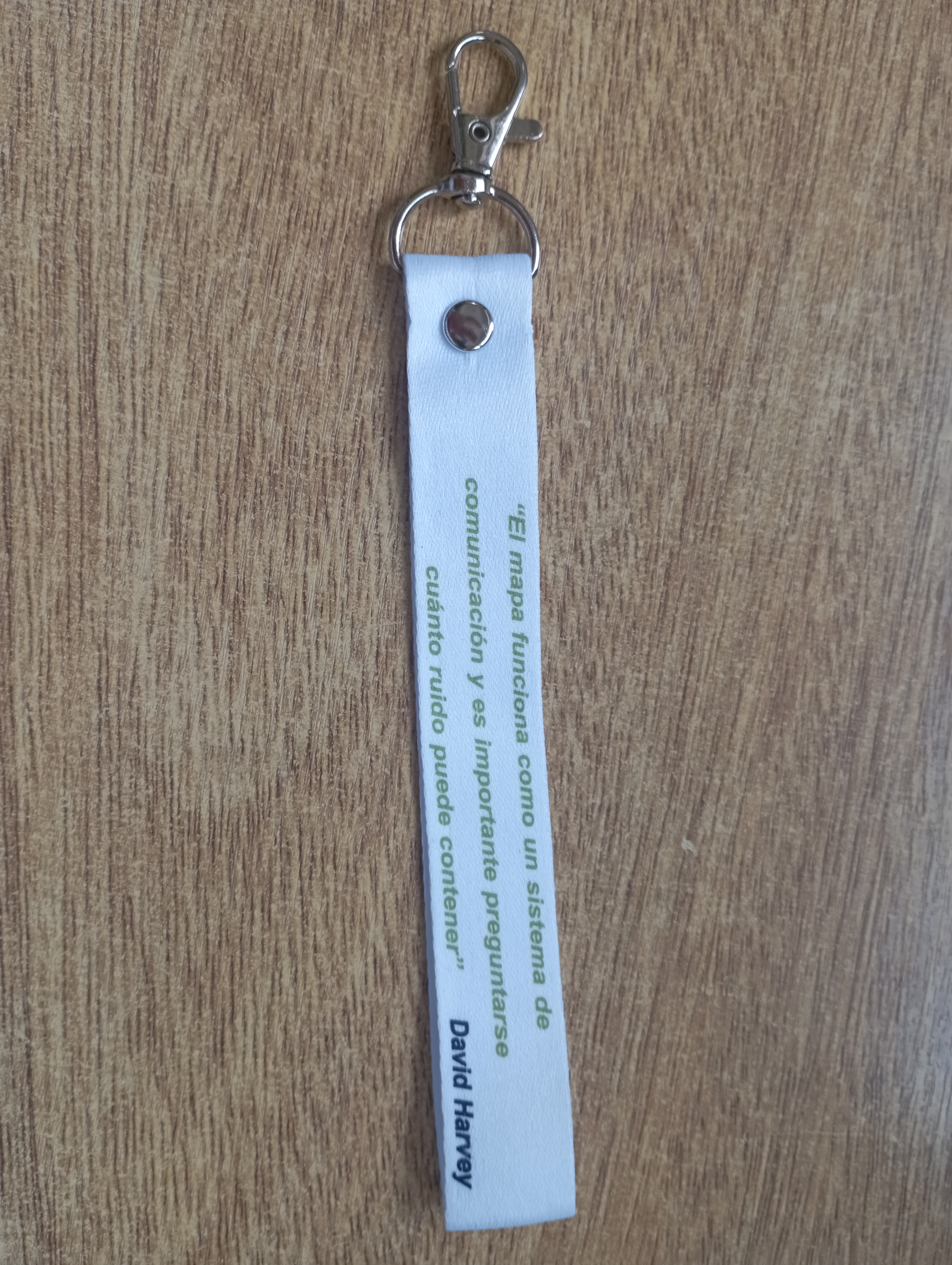Vous pouvez lire le billet sur le blog La Minute pour plus d'informations sur les RSS !
 Géomatique anglophone
Géomatique anglophone
-
sur The True Size of Australia
Publié: 1 January 2024, 10:12am CET par Keir Clarke
The first thing I saw in 2024 was this Tweet by Darren Wiens:Cartographers have long known about the area distortion of the North due to the Mercator projection commonly used on web maps (e.g. Greenland vs. Africa), but weird no one talks about New Zealand being larger than Australia? See for yourself here:True Size of Australia — Darren Wiens (@dkwiens) December 31, 2023 I can assure you that
-
sur Sean Gillies: 2024 running goals
Publié: 1 January 2024, 12:00am CET
I've registered for the Never Summer 100K (my 3rd) at the end of July, the Black Squirrel Trail Half-Marathon (my 4th) in early September, and the Bear 100 Mile at the end of September (my 2nd try). All are events that I've run before, but never as a set. I ran Never Summer and Black Squirrel together in 2021. I did the shorter 60K version of Never Summer last year along with the Bear.
I intend to do Never Summer as part of my build up for the Bear 100. I'll give it a good go, but stay composed, and be mindful that it will be just the first week of my peak training block. I registered for Black Squirrel because I've missed running it, could be really fit that week, and some faster running might be a fun break from the long slogs of late summer.
Finishing the Bear 100 is my number one goal. I'd like to finish and do well at Never Summer and Black Squirrel, too, but am ready to sacrifice these goals if I must.
Along the way to finishing the Bear I'm going to try to add 250 miles at 220 feet per mile to last year's numbers, so 1850 miles running and 275,000 feet of climbing. This is feasible if things go well. I ran 2000 miles in 2021.
I aim to lose at least 15 pounds in the next 9 months so I don't have to drag them for 30 hours through the mountains of Utah and Idaho. I'll have to omit junk food and DIPAs to do it. In their place, I can work on training my stomach to handle Spring Energy gels.
My last goal is to increase the flexibility and durability of my ankles so that I have a better chance of weathering the trails of the Bear in 2024. I'm planning to get some physical therapy help on this early this next spring.
Good luck in reaching your own goals for next year, whether they are on or off trail!
-
sur Tom Kralidis: Cheers to 2023
Publié: 31 December 2023, 8:53pm CET
2023 was a memorable year and quite the ride! Eventful and full swing on so many fronts. Here’s the annual rundown: pygeoapi: two releases, lots of development at code sprints and continuous improvement for the project. Dutch API rules, CRS and increased support for the various standards as they evolve. As well, numerous valuable discussions […] -
sur Sean Gillies: Running in 2023
Publié: 31 December 2023, 2:34am CET
2023 was a pretty good running year. I was both ambitious and conservative, overcame some adversity and learned a lot. The numbers for 2023:
363 hours
1610 miles
220,128 feet D+
3 ultra finishes
1 DNF
Coming off a down year, I signed up for my first 100 mile run, and tried to do it on fairly minimal training relative to the big miles I ran in 2021. I got my third Quad Rock 50 mile finish in May, did the Kettle Moraine 60K fun run in June, and the Never Summer 60K in July.
I had to manage and run through an episode of intense back pain in July, but recovered in time for the Bear 100 in September. At that race I was on track to finish in less than 36 hours, but wrecked my left ankle and dropped out at 61 miles. I'm going to try it again.
I ran fewer miles than in 2019-2021 years, but did a lot of climbing (including a new weekly total high), and started 4 ultra-marathons. That's a new high for me.
In 2024, I'll be trying a different mix of events. And I'll be back here at Kelly Lake.
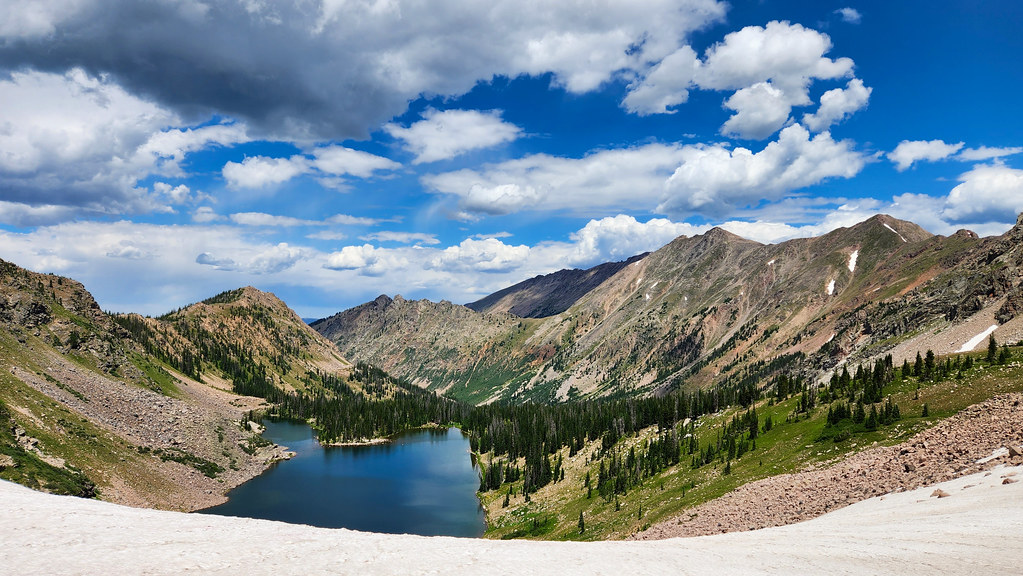
Kelly Lake at Never Summer 2023
-
sur From GIS to Remote Sensing: Remotior Sensus Update: Version 0.3
Publié: 30 December 2023, 1:38pm CET
I'm glad to announce the update of Remotior Sensus to version 0.3.The main new feature is a new module for displaying an interface similar to the Semi-Automatic Classification Plugin (which is based on Remotior Sensus) in Jupyter notebooks.Jupyter notebooks are interactive documents that can be edited in a web browser, which allow for coding in Python and interact with widgets.
The Jupyter interface is still in development and only a few tools are available. For the moment, the available tools are:- search and download of remote sensing images;
- creation and management of Band Sets;
- the dock for creating a training input and saving ROIs created interactively through polygons or region growing;
- the import of vectors in training input;
- the plot of spectral signatures;
- the classification of the Band Sets;
- a file browser for selecting files or directories.
import remotior_sensus rs = remotior_sensus.Session(n_processes=2, available_ram=1000) rs.jupyter().download_interface()

Of course this is a proof of concept, considering that this interface doesn't have all the functions of the Semi-Automatic Classification Plugin, and there are a few differences in the look and feel because of the characteristics of Jupyter notebooks.A tutorial describing this new feature will be released soon.
For any comment or question, join the Facebook group or GitHub discussions about the Semi-Automatic Classification Plugin.
-
sur Real-Time 3D Mapping
Publié: 30 December 2023, 10:24am CET par Keir Clarke
Kaiwen Song and Juyong Zhang of the University of Science and Technology of China claim to be "the first to achieve real-time rendering of large-scale scenes" through the use of neural rendering. They have presented their findings to the world in their paper City-on-Web: Real-time Neural Rendering of Large-scale Scenes on the Web (the website of which includes three live demos). Neural Radiance
-
sur Andrea Antonello: SMASH 1.8 is out!
Publié: 29 December 2023, 4:58pm CET
Dear all, it has been a while, but some stuff has been going on in the SMASH community. And we now have a new release. So let's have a look at what is new.
We farewell the play storeIt is a while we have additional work to do and are loosing usability in SMASH due to the restrictions imposed by the google store. The most impacting has sure been the fact to not be able to access the phone memory freely. And asking google permission to do so didn't work out, since it seems that only file browsers applications and antivirus need to access the memory freely.
With the help of the F-Droid community (special thanks to IzzySoft, Linsu and Licaon-kter) we have been able to make our second appearance on the f-Droid store. And that is now enough to completely migrate there. So we made a last release of SMASH for the store today, but it will be the last one. Please from now on come and get SMASH from the F-Droid store, where the real open source apps live.
Flutter mapWe finally made an upgrade of flutter_map, the map widget library used. This took so long, because the architecture of the library had changed and took some rework inside SMASH.
And now on to the new features:
Geometries inside formsOne nice addition that we have to thank Luca Delucchi and the Digiagriapp for is the possibility to insert inside of complex notes.
URL based forms combosIt is now possible to insert in forms URLs to substitute long item lists in comboboxes (dropdown lists). This allows forms to be smaller in case of large amounts of items and also to be more dynamic.
Gejson layer supportGeojson is now one of the supported formats in read and write mode (together with geopackage and postgis). It can be used in combination with sld styling as for the other vector formats.
More efficient toolbarThe toolbar has been redone with more usability in mind.
Editing is done on a sidebar now:
and in the settings it is possible to remove unused buttons:
leads to:
Other tiny things that might be worth telling- now the default behavior of tile maps is to zoom beyond the max zoom level by scaling (no more white emptiness)
- the current log panel has now 3 sizes for better overlay on map
- the info tool is now a box selection tool and as such way more usable
- online sources have been reworked to have the possibility to add and remove from the default. Also the default maps have been reviewed to ensure they are working
- feature info now also presents the length and area of the geometry as derived value
- we did many many bugfixes
One last thing to add. SMASH 1.8 already presents the possibility to import layers from the new GSS server. This is still in testing mode and ongoing work with the Region Piemonte and not yet disseminated as such. Just to give an idea, it will be possible to generate database tables on the server based on form definitions and download the tables as layers from the GSS and sync them two-ways. Also it will allow for point, line and polygon geometries. All in all it will be an alternative way to take notes, still using the form system and having a way to synchronize data to teh central server instance. But well, this will probably be the next story to tell, once testing is done.
Enjoy!!
-
sur GeoTimeGuessr
Publié: 29 December 2023, 10:53am CET par Keir Clarke
Today we have a huge treat for fans of the popular GeoGuessr game. GeoGuessr is a geography game that takes you on a virtual trip around the world, blindfolded! It uses Google Street View to drop you in a random location somewhere on the planet, and your task is to figure out where you are based on the visual clues that you see around you.TimeGuessr is a very similar game to GeoGuessr - except
-
sur SIG Libre Uruguay: Y se va el último…
Publié: 28 December 2023, 2:36pm CET
-
sur SIG Libre Uruguay: ¡Colombia bien representada!
Publié: 28 December 2023, 2:35pm CET
-
sur gvSIG Batoví: Repaso a los proyectos premiados (final) en el Curso–Concurso Geoalfabetización mediante la utilización de Tecnologías de la Información Geográfica
Publié: 28 December 2023, 2:25pm CET
Para despedirnos por este año elegimos comentar otro proyecto que bien podía haber integrado la lista de finalistas, y que por el altísimo nivel alcanzado, tal vez injustamente, ha quedado fuera del podio:
 Título: 10 años del Geoparque Mundial UNESCO Grutas del Palacio
Título: 10 años del Geoparque Mundial UNESCO Grutas del Palacio
Institución: Liceo Departamental N° 1
Localidad: Trinidad
Docente de referencia: Gerardo Moraes
Tutora: Nadia ChaerQueremos resaltar especialmente este proyecto por varias razones:
- porque realizaron una publicación como parte del proyecto, en la que utilizaron los mapas creados con gvSIG Batoví
- porque los estudiantes extendieron lo que habían aprendido a otros estudiantes, en este caso de Educación Primaria, a través de la realización de varios talleres en la escuela N°31 de Trinidad, departamento de Flores (Uruguay); pueden ver un video aquí
- y porque presentaron su proyecto de una forma muy interesante, amena e interactiva
Este proyecto, realizado por estudiantes de 5° Humanístico (16 y 17 años), ha destacado también por la gran cantidad y calidad de trabajo producido: hasta elaboraron los diplomas a entregar a los participantes de los talleres escolares antes mencionados.
Nuestras felicitaciones a todo el equipo por el estupendo proyecto que han desarrollado (¡en sólo 3 meses!). Y nuestras felicitaciones también a todos los demás equipos porque, como dijimos anteriormente, en esta iniciativa no hay perdedores, sólo ganadores.

-
sur Subway Specs - Part III
Publié: 28 December 2023, 10:20am CET par Keir Clarke
Tokyo's Shinjuku Station is the world's busiest train station. Its is used by over 3.5 million passengers every day. To cope with that amount of traffic the station has to be very big. It has 35 platforms, while another 17 platforms can be accessed through hallways to 5 directly connected stations without traveling outside. With over 35 platforms and over 200 station exits it can be easy to
-
sur gvSIG Batoví: Repaso a los proyectos premiados (IV) en el Curso–Concurso Geoalfabetización mediante la utilización de Tecnologías de la Información Geográfica
Publié: 27 December 2023, 3:29pm CET
Dedicamos este post muy especialmente a los proyectos participantes desde Colombia, ya que es la primera vez que esta iniciativa cuenta con concursantes extranjeros.
 equipo del proyecto 6 Turismo, Desarrollo y Medio Ambiente en Choachí presentando mediante video-conferencia su trabajo frente a los demás equipos concursantes
equipo del proyecto 6 Turismo, Desarrollo y Medio Ambiente en Choachí presentando mediante video-conferencia su trabajo frente a los demás equipos concursantes
Para ello contamos con la colaboración de la Gobernación de Cundinamarca, a través de su Secretaría de Educación, que nos permitió extender la iniciativa del curso-concurso a todas la IED (instituciones educativas departamentales) de ese departamento colombiano.
 defensa final del proyecto 8 Conectando con el Agua: Georreferenciando El «Páramo de Guerrero» en Subachoque y su Importancia Hídrica frente a integrantes del jurado, y acompañados por su tutor
defensa final del proyecto 8 Conectando con el Agua: Georreferenciando El «Páramo de Guerrero» en Subachoque y su Importancia Hídrica frente a integrantes del jurado, y acompañados por su tutor
Todos los equipos han hecho un excelente trabajo, a pesar de las dificultades que el traslado de la experiencia naturalmente implicaba: trabajo 100 % desde la virtualidad, aprendizaje de tecnologías desconocidas hasta el momento, diferencias culturales, dificultades en cuanto a la conectividad, etc. Al respecto cabe destacar la actitud de todos los equipos, siempre con la mejor disposición para capacitarse y para comprender los inconvenientes que pudieran surgir, así como para compartir conocimientos y aprendizajes.
 el equipo del proyecto 11 Mapeando nuestro territorio: Tabio compartiendo su trabajo con los demás participantes
el equipo del proyecto 11 Mapeando nuestro territorio: Tabio compartiendo su trabajo con los demás participantes
Queremos agradecer muy especialmente a quienes colaboraron desde la Secretaría de Educación de la Gobernación de Cundinamarca (Colombia), en particular a Efraín Castro; también a los equipos que se animaron a participar de la iniciativa y que han realizado impresionantes trabajos, además de demostrar una enorme paciencia hacia nosotros, organizadores de la propuesta; por último pero no menos importante, a Luis Vilches por haber logrado que esta participación desde Colombia finalmente se pudiera concretar. De nuestra parte, nos sentimos muy privilegiados de haber compartido un año más este proyecto con todos ustedes, e inmensamente agradecidos pues -una vez más- hemos aprendido mucho todos nosotros de esta hermosa experiencia.
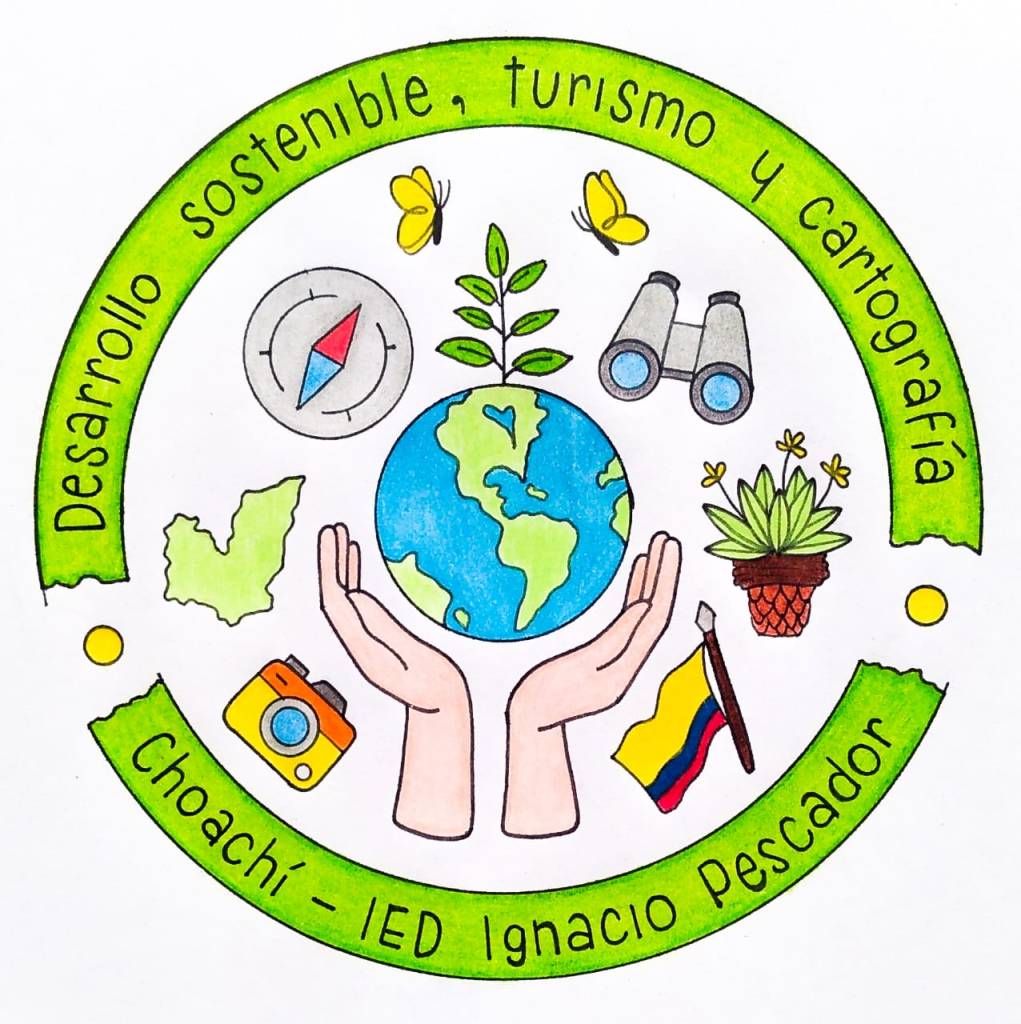 logo proyecto 6
logo proyecto 6
 logo proyecto 8
logo proyecto 8
 logo proyecto 11
logo proyecto 11
Por decisión del jurado resultó ganador el proyecto 6. El mismo fue desarrollado por estudiantes de décimo y undécimo grado de la IED Ignacio Pescador de la localidad de Choachí, siendo su docente de referencia la profesora Astrid Corredor. Asistió como tutor Neftalí Sillero, de la Faculdade de Ciências da Universidade do Porto (Portugal)
Pueden acceder a los demás proyectos en los siguientes enlaces:
proyecto 8: Conectando con el Agua: Georreferenciando El «Páramo de Guerrero» en Subachoque y su Importancia Hídrica, de estudiantes de séptimo, octavo y décimo de la IED La Pradera de la localidad de Subachoque. Docente de referencia: Sandra Milena Diaz Vargas; tutor: Antoni Pérez Navarro, profesor de los Estudios de Informática, Multimedia y Telecomunicación, Universitat Oberta de Catalunya (España);
proyecto 11: Recurso hídrico del municipio de Tabio: cuidado y preservación de la subcuenca del Río Chicú, de estudiantes de noveno y décimo de la IED Instituto Tecnico Comercial José de San Martín de la localidad de Tabio. Docente de referencia: John Castrillón; Tutora: Nadia Chaer, de la Comunidad gvSIG Uruguay (Uruguay);
-
sur QGIS España: Participación en la GeoCamp 2023
Publié: 27 December 2023, 3:00pm CET
GeoCamp ESGeoCamp es un congreso nacional sin ánimo de lucro, que nació en 2013 y que organiza anualmente el colectivo internacional de Geoinquietos. Esta Comunidad está formada por grupos informales que se reúnen para hablar y aprender sobre cualquier tema relacionado con las ciencias de la tierra y que siente una especial afinidad por los servicios de geodatos abiertos, proyectos comunitarios, software libre y aplicaciones SIG (Sistemas de Información Geográfica), especialmente los desarrollados en torno a la comunidad OSGeo (Open Source Geospatial).
Este año Geocamp ha celebrado su 10ª Edición en septiembre en la isla de la Illa de San Simón en la ría de Vigo (Galicia - España) y ha tenido un formato Open Space, donde todos los participantes tienen un papel activo en la realización del evento para aumentar la interacción entre los asistentes para poder, con agilidad e improvisación, satisfacer espontáneamente las inquietudes de los participantes.
Empezó el evento con un maravilloso día soleado y con la isla de San Simón recibiendo a los más de 40 participantes que llegamos en barco desde el puerto de Vigo atravesando la ría, en un viaje muy interesante, amenizado con la información histórica y cultura local de mano de los tripulantes. La pequeña isla con sus históricos edificios donde se podían configurar varios espacios, permitió la realización de numerosas actividades y reuniones, tanto dentro como en el exterior.
A lo largo de la jornada se pudieron realizar seis espacios abiertos donde se habló y debatió sobre los temas que se eligieron por la propia iniciativa, interés y propuestas de los asistentes, y que fueron votados y aceptados por todos y cuyos puntos a destacar se pueden consultar aquí, documento resumen elaborado de forma conjunta por los participantes: OSM, Las Calles de las Mujeres, Geoportales participativos, JS y Web GL, Inteligencia Artificial y mapas, Teledetección, estado de las Comunidades, Estándares OGC y Blockchain.
La charla plenaria que ofreció Carmen Torrecillas de la organización Civio nos mostró cómo hacer mapas y visualizaciones increíbles, gracias al gran trabajo que hacen por la transparencia y la vigilancia de los poderes públicos.
Por supuesto, además, se comentaron todo tipo de inquietudes, experiencias, proyectos y objetivos (cómo la forma de manipular un pixel en la GPU, monitoreo de cetáceos, cooperativas, Joomla, montañismo, conjuros, etc.) a lo largo de todos los momentos en los que se pudo charlar mientras se disfrutaba de los ricos manjares gallegos, con los que se amenizaron los desayunos, comida y cena en un ambiente amable y creativo. Incluso pudimos disfrutar de fantásticas experiencias de la mano de nuestros organizadores fuera de programa como un concierto de rock ( @fpsampayo) o una queimada ( @michogar) cómo no podía ser de otra manera en esta maravillosa ciudad gallega.
La organización local reservó una cena para aquellos que querían seguir compartiendo charlas y espacio. Aunque no es algo estrictamente necesario en un evento participativo como este, siempre ayuda a crear contactos y sinergias. De hecho, muchos de los asistentes, sobre todo si han tenido que venir de otras partes de la península y tienen que hacer noche en la ciudad, lo agradecieron y acudieron para cerrar de una manera festiva el encuentro.
Como conclusiones, señalar que el formato de Open Space funcionó muy bien, contando con un amplio espacio disponible lo que facilitó la organización e incluso la gente se podría haber repartido en más grupos si hubiera sido necesario. De hecho, con grupos algo más reducidos se puede trabajar mejor la participación, aunque fue en éxito con grupos de unas 20 personas. Fue de agradecer haber previsto, mediante un formulario que se hizo llegar a los asistentes, una serie previa de temas a tratar agilizando la organización de los grupos. Realmente es un formato único para crear comunidad, aprender cosas nuevas y llevarse a casa un buen número de conocimientos e ideas. Muy gratificante haber podido conocer gente que no sabía lo que era este tipo de evento y que se encuentran con una experiencia realmente satisfactoria, donde se han podido compartir conocimientos en un ambiente participativo y distendido, que ayuda realmente a contactar a personas que ya tienen experiencia con otras que pueden estar empezando.
Habrá que esperar al año que viene para volver a disfrutar de nuevo de un encuentro tan especial como este.
AgradecimientosFelicitaciones a la organización:
Micho ( @michogar), Paco ( @fpsampayo), Pablo ( @psanxiao), Carmen ( @carmen10maica) y Jorge ( @xurxosanz) por montar el evento, así como a Xeoinquedos y Ghandalf por la cobertura.
También por supuesto a los que han confiado y apoyado económicamente el evento, ya que sin ellos no hubiera sido posible llevarlo a tan buen término (por orden cronológico de participación):
Elastic; QGIS España; B’GEO; PSIG; solucions geografiques; GeoInnova; icarto.es/; Master SIG, UNIGIS Girona; geomatico; conterra; OSGeo; asefor; abtemas; Xunta de Galicia
Enlaces de interés-
Web del evento: [2023.geocamp.es]
-
Ediciones de GeocampES: [https:]]
-
Resumen del evento: [https:]]
-
@geocampes en X/Twitter: [https:]]
-
Grupo de GeoCamp - 2023 en Telegram: [https:]]
-
Geocamp2023 en Instagram:
-
-
sur SIG Libre Uruguay: ¡UTU presente!
Publié: 26 December 2023, 8:34pm CET
-
sur SIG Libre Uruguay: sucu67
Publié: 26 December 2023, 8:33pm CET
-
sur SIG Libre Uruguay: Vale la pena echarle un vistazo…
Publié: 26 December 2023, 8:32pm CET
-
sur gvSIG Batoví: Repaso a los proyectos premiados (III) en el Curso–Concurso Geoalfabetización mediante la utilización de Tecnologías de la Información Geográfica
Publié: 26 December 2023, 3:20pm CET
Finalizando este repaso a los proyectos uruguayos premiados, toca el turno al proyecto N°3 denominado Geo 7°F.
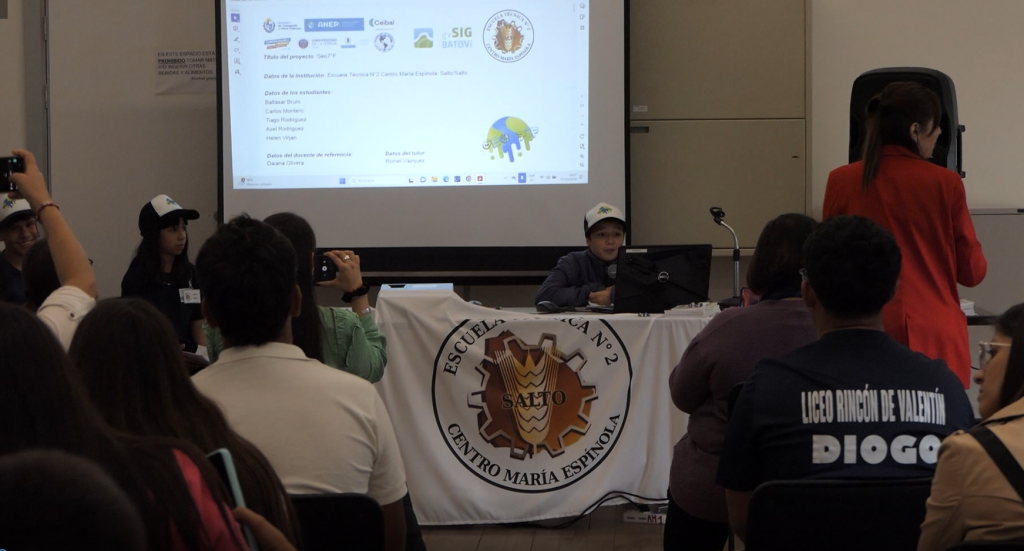 el equipo presentando su proyecto frente a los demás equipos concursantes
el equipo presentando su proyecto frente a los demás equipos concursantes
El proyecto fue desarrollado por estudiantes (de 12 y 13 años) de la Escuela Técnica N°2 CME de la ciudad de Salto. La docente de referencia fue la profesora Daiana Olivera y el tutor del proyecto fue Romel Vázquez de la Universidad Central «Marta Abreu» de Las Villas (Cuba). El tema elegido fue el de las crecidas del río Uruguay y su influencia en la población de la ciudad de Salto.
 logo del proyecto
logo del proyecto
Todos los proyectos han tenido sus particularidades; en este caso se trata del primer proyecto premiado perteneciente a una Escuela Técnica, siendo éste el primer año en que participan. La evolución que ha tenido este proyecto -en los escasos 3 meses de desarrollo- ha sido fantástica.
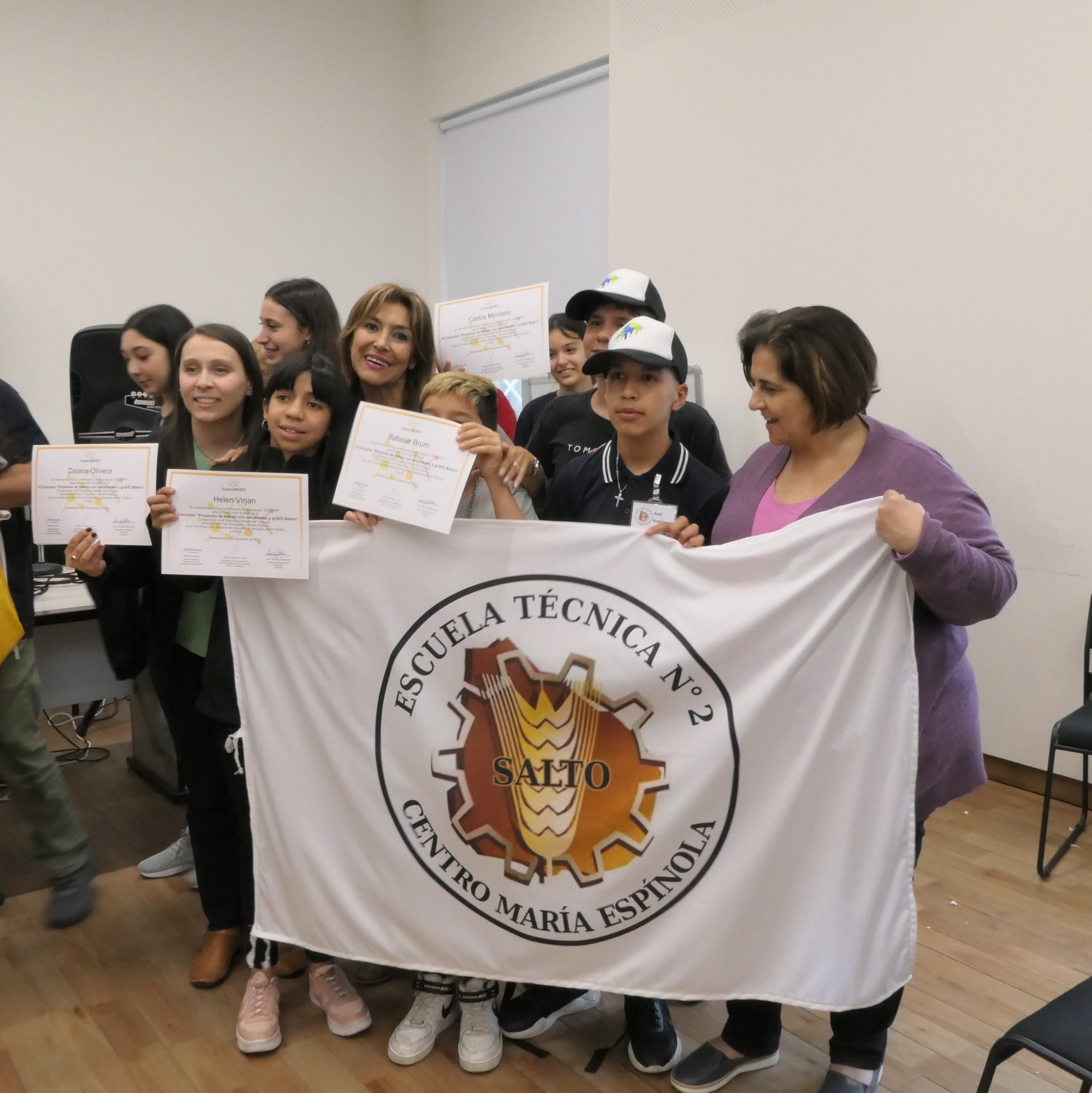 el equipo recibiendo su merecido diploma, junto a autoridades de la enseñanza
el equipo recibiendo su merecido diploma, junto a autoridades de la enseñanza
Es emocionante ver cómo cada equipo se entusiasma con sus proyectos, lo que se percibe en la jornada de cierre, a la que concurren con remeras, gorros y banderas con el logo que ellos mismos elaboraron (y algún souvenir más, como el caso de este equipo):
Pueden acceder al proyecto aquí
Queremos felicitar a todos los integrantes de equipo del Proyecto Nº3 Geo 7°F por su increíble trabajo
-
sur Santa Tracker Maps
Publié: 24 December 2023, 10:00am CET par Keir Clarke
Santa has begun work on his busiest day of the year. This year you can follow Santa's journey around the world, as he delivers presents to all the world's children, on both the Google Santa Tracker and the NORAD Santa Tracker. You can also follow Santa this year on the new Mapbox powered Santa Tracker.The Mapbox Santa Tracker consists of a 3D map encased in a 3D snow-globe (shake the globe to
-
sur QGIS Blog: QGIS Annual General Meeting – 2023
Publié: 23 December 2023, 11:00pm CET
Dear QGIS Community,
We recently held our 2023 QGIS Annual General Meeting. The minutes of this meeting are available for all to view.
This year, we did not have PSC elections. Anita Graser will continue as Vice-Chair, I will continue to serve on the PSC as chair, and our longstanding treasurer, Andreas Neumann, will complete the board. Furthermore, Jürgen Fischer, Alessandro Pasotti, and Régis Haubourg will continue on the PSC. Last but certainly not least, the PSC is completed by our project founder, Gary Sherman, and long-term PSC member Tim Sutton, who serve on the PSC as honorary PSC members. They both set the standard for our excellent project culture, and it is great to have his continued presence.
QGIS has been growing from strength to strength, backed by a fantastic community of kind and collaborative users, developers, contributors and funders. This year, we reached another important milestone for the project’s sustainability by welcoming our first flagship sustaining member – Felt. I look forward to seeing how it continues to grow and flourish.
Rock on QGIS!
Cheers
Marco Bernasocchi (QGIS.ORG Chair)
-
sur Where Might I Live?
Publié: 23 December 2023, 10:31am CET par Keir Clarke
There are 3,143 counties in the USA. One of them is probably perfect for you. But which one?What makes a perfect home can depend on a number of factors. Those factors are likely to be different for every single person. Where Might I Live can find your perfect US home based on your own personal criteria. Tell Where Might I Live what factors are important to you in choosing a home and it will
-
sur gvSIG Batoví: Repaso a los proyectos premiados (II) en el Curso–Concurso Geoalfabetización mediante la utilización de Tecnologías de la Información Geográfica
Publié: 22 December 2023, 4:29pm CET
Hoy nos toca comentar el proyecto N°5 denominado Mentes en crecimiento: Estudio de la leishmaniasis en el contexto del liceo N°2 de Salto: amenazas, debilidades, fortalezas y oportunidades en la actualidad. Este proyecto merece un destaque especial pues es continuación de otro que concursó en la edición anterior (de 2022) y que también resultó premiado.
 el equipo presentando su proyecto frente a los demás equipos concursantes
el equipo presentando su proyecto frente a los demás equipos concursantes
El proyecto fue elaborado por estudiantes del Liceo Nº2 Dr. Antonio M. Grompone de la ciudad de Salto, siendo su docente de referencia la profesora María Patricia Leal, y su tutor Carlos Lara de la Facultad de Ciencias de la Universidad Católica de la Santísima Concepción (Chile). El tema del proyecto fue realizar un estudio descriptivo sobre las condiciones ambientales que favorecen la proliferación del vector Ludzomia Longipalpis, para promover acciones de salud tales como la promoción y prevención de la Leishmaniasis Visceral, que impacten positivamente a nivel comunitario.
 logo del proyecto
logo del proyecto
Y debemos decir que los estudiantes integrantes del equipo (de 14 y 15 años de edad) hicieron algo que parecía difícil de conseguir: mejorar lo hecho el año anterior. Se trata de un gran trabajo que destaca tanto por la cantidad como por la calidad del material producido, que trascendió ampliamente los objetivos del concurso (por ejemplo, en la invención de un repelente natural contra el flebótomo (vector de trasmisión de la leishmaniasis) y de una trampa de luz para su captura)
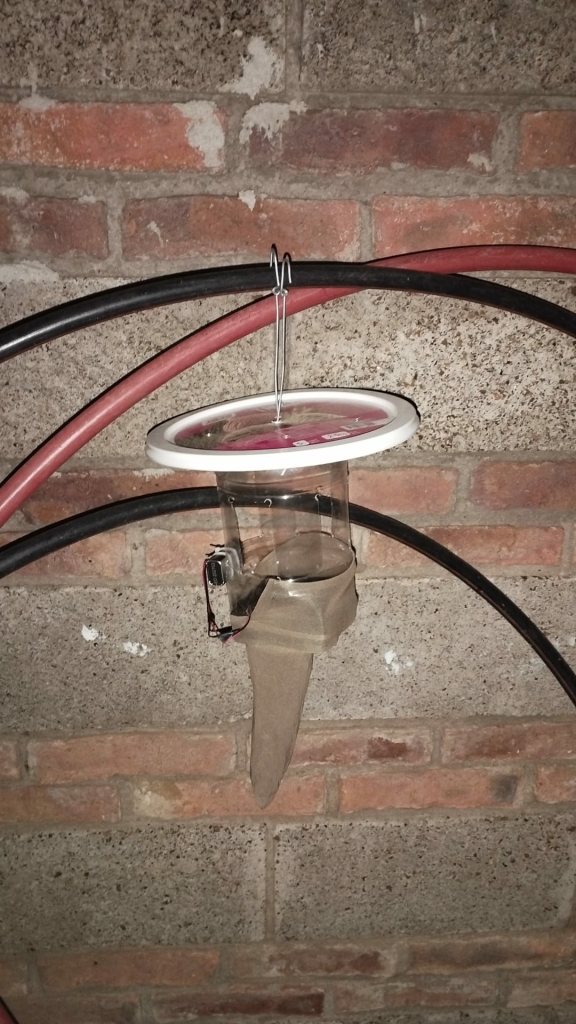 trampa de luz
trampa de luz
El equipo también realizó una página web del proyecto, algo que no era exigencia del concurso. Como en el caso anterior, recomendamos muy especialmente darle una hojeada: enlace aquí. Podrán apreciar por ustedes mismos todo lo que ha trabajado este equipo (especial atención a la sección Territorialización)
Se estarán imaginando lo difícil que lo tuvo el jurado para emitir su fallo pues el nivel ha sido muy alto, y se desarrollaron varios proyectos excelentes, los que no tienen nada que envidiar a un trabajo académico o a un estudio de una consultora.
 los estudiantes en plena tarea
los estudiantes en plena tarea
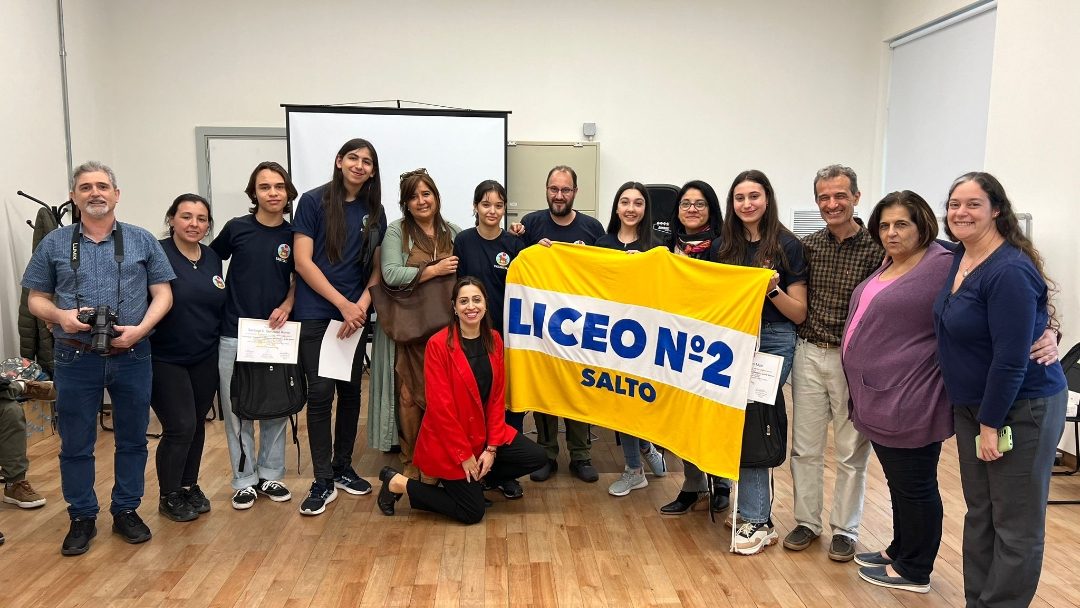 el equipo, junto a integrantes del Equipo Coordinador
el equipo, junto a integrantes del Equipo Coordinador
Nuestras más sinceras felicitaciones al equipo del proyecto N°5 Mentes en crecimiento. Impresionante trabajo.
-
sur KAN T&IT Blog: Balance de Fin de Año
Publié: 22 December 2023, 1:30pm CET
Este es el momento perfecto para reflexionar sobre los logros alcanzados y los desafíos superados en este 2023. Kan Territory & IT, líder en el ámbito de las Geosoluciones para empresas, ha vivido un año excepcional, marcado por innovaciones, participaciones inspiradoras y un compromiso continuo con la excelencia.
Este año no solo hemos mantenido la posición en la vanguardia de las tecnologías geoespaciales, sino que también hemos lanzado productos revolucionarios. Desde soluciones de mapeo más intuitivas hasta plataformas de análisis predictivo, nuestra gama de productos se ha expandido para satisfacer las crecientes demandas del mercado. Estamos emocionados por los éxitos logrados con estas nuevas herramientas, que han permitido a nuestros clientes optimizar sus operaciones y tomar decisiones más informadas.
Consideramos que establecer vínculos sólidos con la comunidad empresarial y tecnológica es fundamental para garantizar un crecimiento sostenible. En consecuencia, durante el transcurso de este año, nos involucramos de manera activa en diversas instancias de intercambio y aprendizaje, tanto a nivel nacional, como fue el caso de las Jornadas de IDERA en La Pampa, como a nivel internacional, participando en eventos destacados como la Foss4G en Kosovo y Baltimore, Big Data for Space en Austria, y el UN-GGIM América en Chile y UN-GGIM Internacional en Nueva York. En todas estas instancias, nuestro compromiso fue compartir valiosos conocimientos, experiencias y perspectivas relacionadas con las últimas tendencias en geosoluciones. Desde conferencias magistrales hasta talleres prácticos, nuestro equipo desempeñó un papel activo en fomentar un diálogo enriquecedor que ha contribuido significativamente al progreso de la industria.
Al mirar hacia atrás, estamos agradecidos por el apoyo continuo de nuestros clientes, socios y colaboradores. Cada logro de Kan Territory & IT es el resultado de un esfuerzo colectivo y de la confianza depositada en nosotros. Miramos hacia el futuro con optimismo, comprometidos a seguir innovando y ofreciendo soluciones que transformen positivamente la manera en que las empresas gestionan sus datos geoespaciales.
Queremos expresar nuestro agradecimiento a todos los que han sido parte de nuestro viaje. Que el próximo año esté lleno de nuevos horizontes, oportunidades emocionantes y éxitos compartidos. Que el 2024 sea un año de crecimiento, innovación y colaboración continua.
El equipo Kan & It
-
sur Destroying People's Homes in Gaza
Publié: 22 December 2023, 10:56am CET par Keir Clarke
The International Committee of the Red Cross (ICRC) has begun creating interactive 3D models of destroyed homes, hospitals and businesses in order to help convey the devastation that ongoing military conflicts can have on ordinary people's lives. Using photogrammetry the ICRC has managed to create harrowing 3D models of an apartment block in Gaza destroyed by an Israeli airstrike in 2021, a
-
sur GeoTools Team: GeoTools 29.4 released
Publié: 21 December 2023, 10:52am CET
GeoTools 29.4 released The GeoTools team is pleased to announce the release of the latest maintenance version of GeoTools 29.4: geotools-29.4-bin.zip geotools-29.4-doc.zip geotools-29.4-userguide.zip geotools-29.4-project.zip This release is also available from the OSGeo Maven Repository and is made in conjunction with GeoServer
-
sur The Battle of Hong Kong
Publié: 21 December 2023, 10:48am CET par Keir Clarke
On the same morning that the Japanese attacked Pearl Harbor (Sunday, December 7, 19411) they also attacked the British Crown colony of Hong Kong. The Hong Kong garrison (consisting of British, Indian and Canadian units, the Auxiliary Defence Units and Hong Kong Volunteer Defence Corps) managed to hold out for over two weeks. However on Christmas Day 1941 the colony finally surrendered to the
-
sur gvSIG Batoví: Repaso a los proyectos premiados (I) en el Curso–Concurso Geoalfabetización mediante la utilización de Tecnologías de la Información Geográfica
Publié: 20 December 2023, 8:23pm CET
Habiendo culminado una nueva edición del Curso–Concurso Geoalfabetización mediante la utilización de Tecnologías de la Información Geográfica no queríamos despedir el año sin antes comentar brevemente algunos de los proyectos que han resultado seleccionados por el jurado como finalistas del concurso.
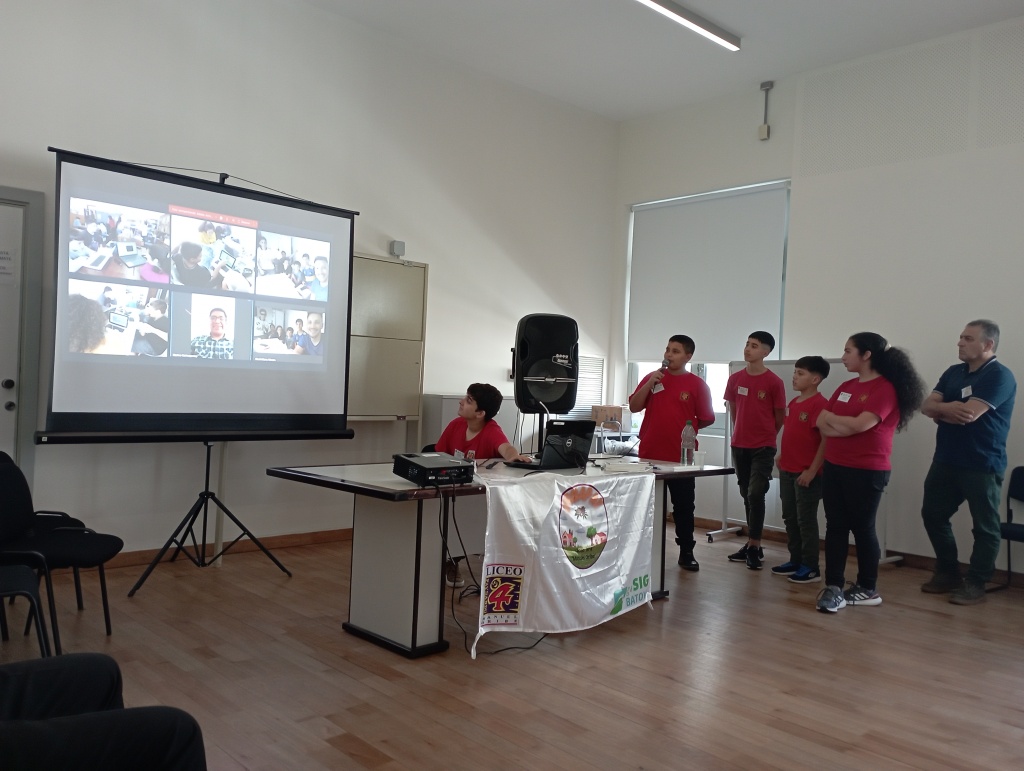 el equipo presentando su proyecto frente a los demás equipos concursantes
el equipo presentando su proyecto frente a los demás equipos concursantes
Comenzaremos por el que resultó ganador por Uruguay, denominado Urbapay (Proyecto N°12). Se trata de un proyecto elaborado por estudiantes de 12 y 13 años del Liceo N°4 Manuel Oribe de la ciudad de Paysandú. El profesor referente es Maximiliano Olivera y la tutoría del proyecto estuvo a cargo de Marino Carhuapoma (de IdeasG, de Perú). El proyecto trata del crecimiento urbano en parte de la ciudad, enfocado desde el punto de vista de los ODS N° 11 y 15, incluyendo propuestas de infraestructura y equipamiento urbano para la zona de estudio
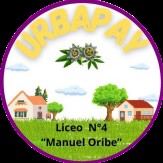
Recomendamos muy especialmente pegarle un repaso a los materiales entregados, donde uno puede apreciar el nivel y la calidad obtenidos en apenas 3 meses de trabajo (échenle un vistazo, por ejemplo, a los mapas elaborados):
Como organizadores de la iniciativa no podemos quedar más que satisfechos por los resultados logrados, que nos demuestran que la idea del curso-concurso no sólo fue (y es) una excelente idea para enseñar de modo ameno, entretenido y profundo, sino que también contribuye en la formación de ciudadanía, al elaborase propuestas que no estaban en la idea inicial del proyecto, y tener éstas un impacto directo en el entorno (muchas de las propuestas que se incluyen en la entrega final terminan materializándose)
 el equipo recibiendo el reconocimiento de las autoridades de la enseñanza de Uruguay
el equipo recibiendo el reconocimiento de las autoridades de la enseñanza de Uruguay
¡Felicitaciones a todos los integrantes del equipo del proyecto N°12 Urbapay!
Continuaremos en siguientes entradas con los demás proyectos.
-
sur Mapping the Alien Invasion
Publié: 20 December 2023, 10:47am CET par Keir Clarke
The National UFO Reporting Center has released a new interactive map which allows the human resistance movement, Networked UFO Tracking Squad (NUTS), to track and organize resistance against the ongoing extraterrestrial invasion of Earth.Thanks to this new global map NUTS has been able to identify hot-spots of alien invasion activity. It is believed that these hot-spots provide a clue as to the
-
sur Paul Ramsey: Data Science is Getting Ducky
Publié: 19 December 2023, 5:00pm CET
For a long time, a big constituency of users of PostGIS has been people with large data analytics problems that crush their desktop GIS systems. Or people who similarly find that their geospatial problems are too large to run in R. Or Python.
These are data scientists or adjacent people. And when they ran into those problems, the first course of action would be to move the data and parts of the workload to a “real database server”.
This all made sense to me.
But recently, something transformative happened – Crunchy Data upgraded my work laptop to a MacBook Pro.
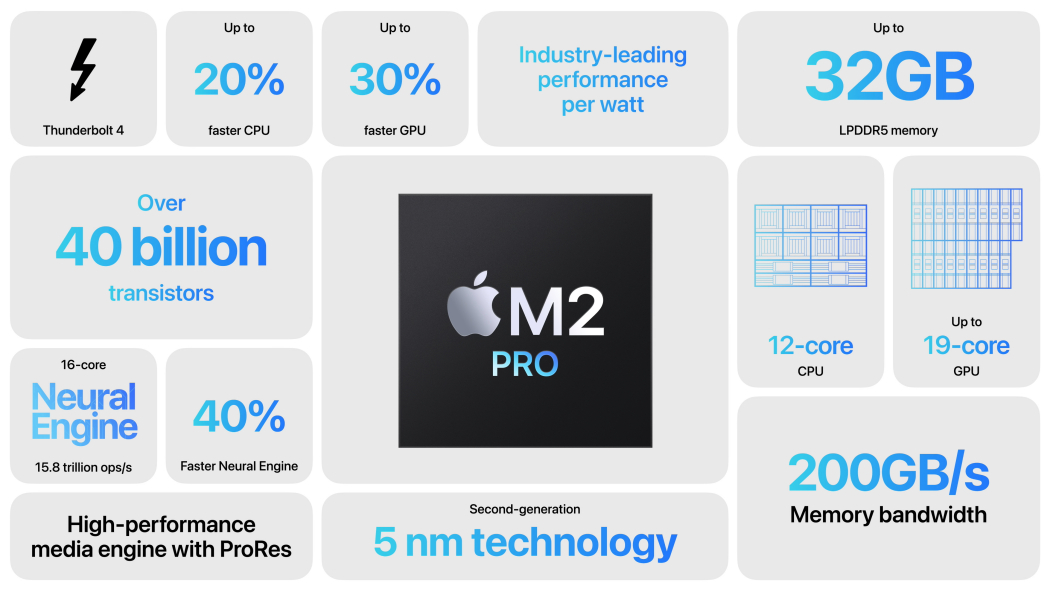
Suddenly a GEOS compile that previously took 20 minutes, took 45 seconds.
I now have processing power on my local laptop that previously was only available on a server. The MacBook Pro may be a leading indicator of this amount of power, but the trend is clear.
What does that mean for default architectures and tooling?
Well, for data science, it means that a program like DuckDB goes from being a bit of a curiosity, to being the default tool for handling large data processing workloads.
What is DuckDB? According to the web site, it is “an in-process SQL OLAP database management system”. That doesn’t sound like a revolution in data science (it sounds really confusing).
But consider what DuckDB rolls together:
- A column-oriented processing engine that makes the most efficient possible use of the processors in modern computers. Parallelism to ensure all CPUs are made use of, and low-level optimizations to ensure each tick of those processors pushes as much data through the pipe as possible.
- Wide ranging support for different data formats, so that integration can take place on-the-fly without requiring translation or sometimes even data download steps.
Having those things together makes it a data science power tool, and removes a lot of the prior incentive that data scientists had to move their data into “real” databases.

When they run into the limits of in-memory analysis in R or Python, they will instead serialize their data to local disk and use DuckDB to slam through the joins and filters that were blowing out their RAM before.
They will also take advantage of DuckDB’s ability to stream remote data from data lake object stores.
What, stream multi-gigabyte JSON files? Well, yes that’s possible, but it’s not where the action is.
The CPU is not the only laptop component that has been getting ridiculously powerful over the past few years. The network pipe that connects that laptop to the internet has also been getting both wider and lower latency with every passing year.
As the propect of streaming data for analysis has come into view, the formats for remote data have also evolved. Instead of JSON, which is relatively fluffy, and hard to efficiently filter, the Parquet format is becoming a new standard for data lakes.
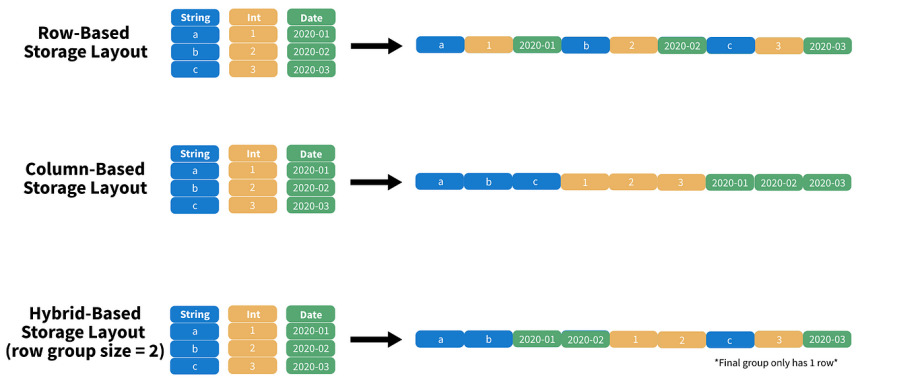
Parquet is a binary format, that organizes the data into blocks for efficient subsetting and processing. A DuckDB query to a properly organized Parquet time series file might easily pull only records for 2 of 20 columns, and 1 day of 365, reducing a multi-gigabyte download to a handful of megabytes.
The huge rise in available local computation, and network connectivity is going to spawn some new standard architectures.
Imagine a “two tier” architecture where tier one is an HTTP object store and tier two is a Javascript single page app? The COG Explorer has already been around for a few years, and it’s just such a two tier application.
(For fun, recognize that an architecture where the data are stored in an access-optimized format, and access is via primitive file-system requests, while all the smarts are in the client-side visualization software is… the old workstation GIS model. Everything old is new again.)
The technology is fresh, but the trendline is pretty clear. See Kyle Barrron’s talk about GeoParquet and DeckGL for a taste of where we are going.
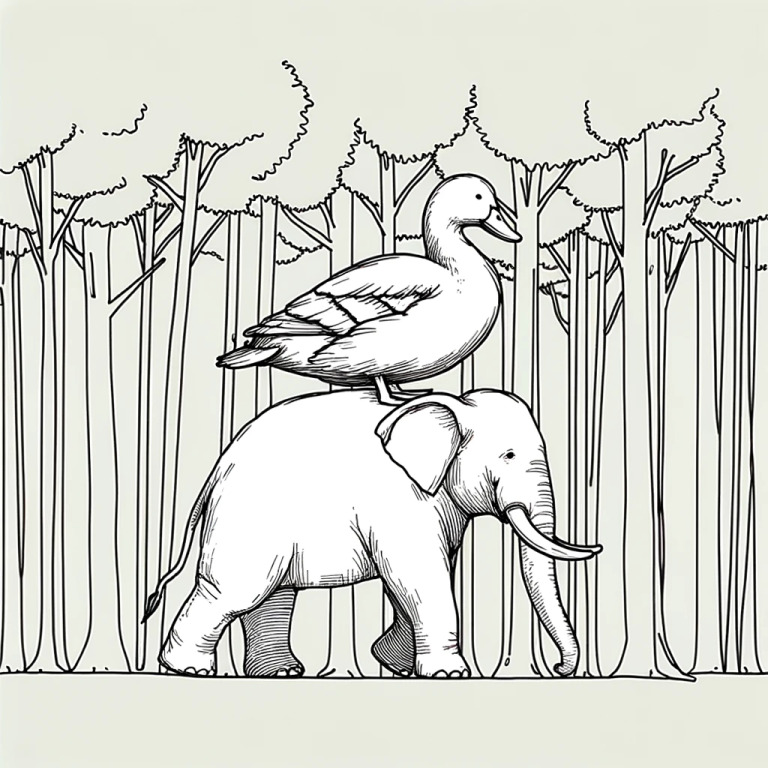
Meanwhile, I expect that a lot of the growth in PostGIS / PostgreSQL we have seen in the data science field will level out for a while, as the convenience of DuckDB takes over a lot of workloads.
The limitations of Parquet (efficient remote access limited to a handful of filter variables being the primary one, as will cojoint spatial/non-spatial filter and joins) will still leave use cases that require a “real” database, but a lot of people who used to reach for PostGIS will be reaching for Duck, and that is going to change a lot of architectures, some for the better, and some for the worse.
-
sur Coin Hoards from the Roman Empire
Publié: 19 December 2023, 11:24am CET par Keir Clarke
Ancient Rome had significant trade links with India, particularly during the Roman Empire under the rule of Augustus and onwards. The Silk Road and Indian Ocean trade routes facilitated the exchange of goods to Rome from India, including textiles, spices, gems, and other luxury items. You can find evidence of this trade between the Roman Empire and India on this interactive map of
-
sur GRASS GIS: Annual Report 2023
Publié: 19 December 2023, 9:12am CET
2023 has been an amazing year in the advancement of the GRASS GIS project, which celebrated its 40th birthday! As the year draws to a close, let’s look back at some of the achievements of the GRASS community. Community Meeting The GRASS GIS Community Meeting held at the Faculty of Civil Engineering of the Czech Technical University in Prague during the first days of June brought together users, supporters, contributors, power users and developers to celebrate, collaborate and chart the future of GRASS GIS. -
sur Jackie Ng: Minor change of plans
Publié: 18 December 2023, 12:14pm CET
There will be a slight change of plans in the MapGuide Open Source 4.0 release timeline.
Namely, the next release will not be the Release Candidate, but rather a 2nd beta release.
The main driver behind this decision is because of my intention to remove the recently introduced support for Mapbox Vector Tiles. While I initially had high hopes with this implementation, additional testing with data outside of the example Sheboygan dataset has revealed rendering issues I do not have the capability to address. Rather than ship a half-baked implementation that may never bake fully, I'd rather bow out while we still can, remove this immature implementation, and leave MVT tile generation to dedicated external tools.
A 2nd beta release will also mean that the other changes I want to get in will also have some time to bake before the Release Candidate stage.
I am hoping the 2nd beta release will be out late January in the new year.
-
sur The Global Birdspotting Map
Publié: 18 December 2023, 10:34am CET par Keir Clarke
BirdWeather uses machine learning to detect and map different species of birds around the world. The platform continuously collects sound from active audio stations distributed across the globe and provides what is effectively an automated AI bird spotting map of the world. Thousands of crowd-sourced audio stations around the world contribute audio data to BirdWeather. Using the BirdNET
-
sur GeoServer Team: GeoServer 2.23.4 Release
Publié: 18 December 2023, 1:00am CET
GeoServer 2.23.4 release is now available with downloads (bin, war, windows), along with docs and extensions.
This is a maintenance release of GeoServer providing existing installations with minor updates and bug fixes. GeoServer 2.23.4 is made in conjunction with GeoTools 29.4, and GeoWebCache 1.23.3.
Thanks to Peter Smythe (AfriGIS) for making this release.
Release notesImprovement:
- GEOS-11152 Improve handling special characters in the Simple SVG Renderer
- GEOS-11154 Improve handling special characters in the MapML HTML Page
- GEOS-11176 Add validation to file wrapper resource paths
- GEOS-11188 Let DownloadProcess handle download requests whose pixel size is larger than integer limits
- GEOS-11189 Add an option to throw a service exception when nearest match “allowed interval” is exceeded
- GEOS-11193 Add an option to throw an exception when the time nearest match does not fall within search limits
- GEOS-11219 Upgrade mail and activation libraries
Bug:
- GEOS-9757 Return a service exception when client provided WMS dimensions are not a match
- GEOS-11074 GeoFence may not load property file at boot
- GEOS-11184 ncwms module has a compile dependency on gs-web-core test jar
- GEOS-11190 GeoFence: align log4j2 deps
- GEOS-11196 NPE in VectorDownload if ROI not defined
- GEOS-11200 GetFeatureInfo can fail on rendering transformations that generate a different raster
- GEOS-11203 WMS GetFeatureInfo bad WKT exception for label-geometry
- GEOS-11206 Throw nearest match mismatch exceptions only for WMS
- GEOS-11223 Layer not visible in preview/capabilities if security closes the workspace, but allows access to the layer
- GEOS-11224 Platform independent binary doesn’t start properly with default data directory
For the complete list see 2.23.4 release notes.
Community UpdatesCommunity module development:
- GEOS-11209 Open ID Connect Proof Key of Code Exchange (PKCE)
- GEOS-11212 ODIC accessToken verification using only JWKs URI
Community modules are shared as source code to encourage collaboration. If a topic being explored is of interest to you please contact the module developer to offer assistance.
About GeoServer 2.23 SeriesAdditional information on GeoServer 2.23 series:
- GeoServer 2.23 User Manual
- Drop Java 8
- GUI CSS Cleanup
- Add the possibility to use fixed values in Capabilities for Dimension metadata
- State of GeoServer 2.23
- GeoServer Feature Frenzy 2023
- GeoServer used in fun and interesting ways
- GeoServer Orientation
Release notes: ( 2.23.4 | 2.23.3 | 2.23.2 | 2.23.1 | 2.23.0 | 2.23-RC1 )
-
sur How Well Do You Know New York's Subway?
Publié: 16 December 2023, 10:56am CET par Keir Clarke
Following the huge success of his London Tube Memory Game Benjamin Tran Dinh released a New York subway version of the game, called the New York City Subway Memory Game.Benjamin's game requires you to name all 472 New York City subway stations. The game is therefore more of a marathon than a sprint and I suspect will take you at least a few hours to complete. If you don't have that much time to
-
sur Free and Open Source GIS Ramblings: Offline Vector Tile Package .vtpk in QGIS
Publié: 15 December 2023, 9:59pm CET
Starting from 3.26, QGIS now supports .vtpk (Vector Tile Package) files out of the box! From the changelog:
ESRI vector tile packages (VTPK files) can now be opened directly as vector tile layers via drag and drop, including support for style translation.
This is great news, particularly for users from Austria, since this makes it possible to use the open government basemap.at vector tiles directly, without any fuss:
1. Download the 2GB offline vector basemap from [https:]]
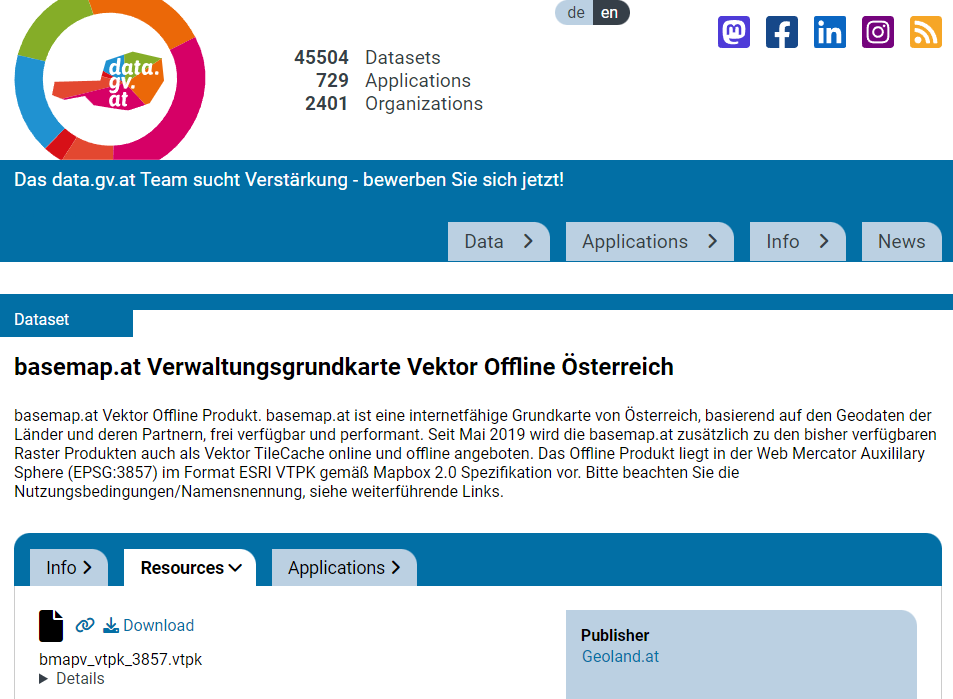
2. Add the .vtpk as a layer using the Data Source Manager or via drag-and-drop from the file explorer
3. All done and ready, including the basemap styling and labeling — which we can customize as well:

Kudos to [https:]] for bringing this new feature to my attention.
PS: And interesting tidbit from the developer of this feature, Nyall Dawson:

-
sur 3liz: Sortie extension Lizmap 4.0.0 pour QGIS
Publié: 15 December 2023, 5:00pm CET
Nouvelles fonctionnalités sur la validation des projetsLors de la publication d'un projet avec le serveur QGIS, il existe quelques problèmes connus lorsque le serveur doit charger le projet :
- Une couche est visible dans QGIS bureautique, mais malheureusement absente dans QGIS serveur.
- Le temps de chargement par QGIS serveur du projet est trop long.
Ces problèmes peuvent avoir différentes sources :
-
Une couche invisible dans QGIS serveur :
- Est-ce que le service PostgreSQL est bien configuré côté serveur ?
- Est-ce que le fichier utilisé pour la couche (FlatGeobuf, Geotiff…) est bien accessible par le serveur avec le même chemin ?
-
Concernant le temps de chargement d'un projet, les sources sont vraiment multiples et peuvent être complexes. Certaines peuvent être simples, comme dire à QGIS d'utiliser les "métadonnées estimées" pour les couches PostgreSQL ou alors de forcer la simplification des géométries côté fournisseur de données.
Ces problèmes sont très courants, c'est pourquoi nous avons décidé d'inclure des règles dans l'extension.
Avec la dernière version de l'extension, vous pouvez commencer à avoir de nouvelles vérifications lors de l'enregistrement de votre fichier de configuration Lizmap. Vous pouvez également remarquer quelques mesures de protection, qui sont conçus pour vous aider à publier votre projet (en évitant certaines erreurs possibles du côté du serveur plus tard).
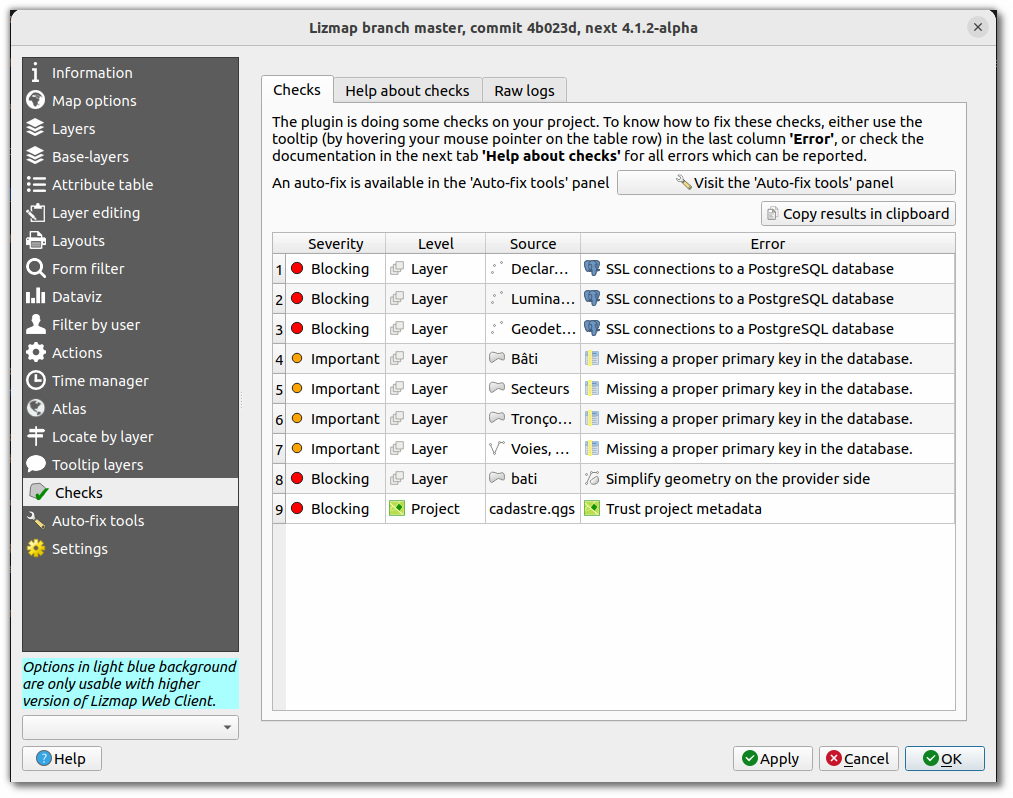
Jetons un coup d'œil rapide à ces deux nouvelles fonctionnalités.
VérificationsAvec la dernière version de l'extension Lizmap, vous pouvez remarquer un nouveau tableau lors de l'enregistrement de votre fichier de configuration.
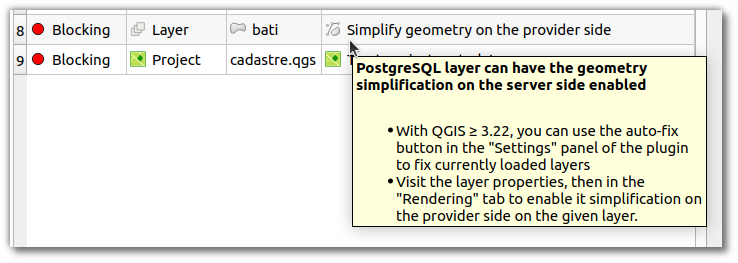
Ce tableau présente les contrôles qui ont échoué lors de la sauvegarde de la configuration.
- Toutes les vérifications sont documentées : source de l'erreur, son nom, comment corriger l'erreur et sa gravité.
- Certaines vérifications sont bloquantes. À l'heure actuelle, seules les vérifications qui prennent au maximum une minute à corriger sont bloquantes. Aujourd'hui, la plupart des règles bloquantes ont des outils pour auto-corriger l'ensemble du projet.
Vous devriez quand même vous pencher sur les autres problèmes non bloquants, car certains d'entre eux réduisent les performances du serveur QGIS. Mais comme ce n'est pas une correction "clé en main", nous n'avons pas rendu ces règles bloquantes.
Pour savoir comment résoudre le problème, passez votre souris sur la dernière colonne du tableau, une description complète apparaîtra. Ou visitez l'onglet suivant qui récapitule l'ensemble des erreurs avec les moyens pour corriger.
Nous ajouterons également de nouvelles vérifications dans les semaines à venir.
Mesure de protectionPar défaut, lors de l'installation de l'extension Lizmap sur un ordinateur, vous serez considéré comme "Débutant". Ce mode est très strict sur ce que vous pouvez faire dans votre projet QGIS. Il a été principalement conçu pour une formation à Lizmap.
Nous pensons que les utilisateurs passeront rapidement en mode "Normal", mais vous pouvez toujours modifier des paramètres dans le dernier panneau.
Ces protections sont conçues pour vous aider. Elles permettent d'éviter que certaines couches ne puissent pas s'afficher sur Lizmap Web Client.
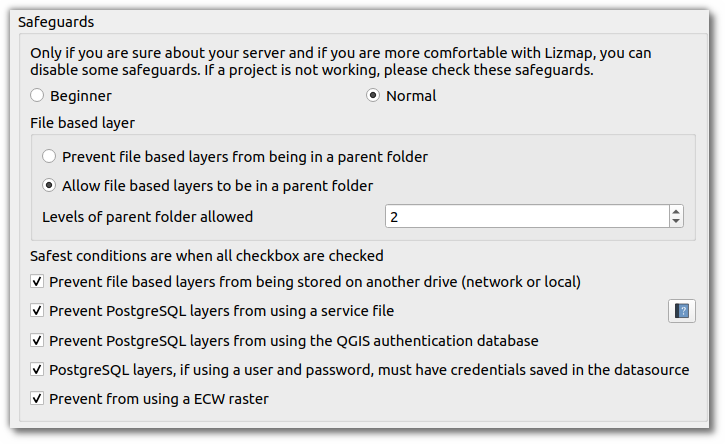
Par exemple, si vous savez que votre serveur ne supporte pas le raster ECW, vous pouvez laisser cette case cochée.
Notez que si vous êtes hébergé sur notre solution Lizmap Cloud, certaines protections sont configurées avec des valeurs par défaut. Par exemple, sur notre solution d'hébergement, le nombre maximum de dossiers parents autorisés lorsque vous ajoutez une couche basée sur un fichier est de deux dossiers.
Lorsque vous êtes en mode "normal", décochez avec précaution ces cases. Certaines d'entre elles nécessitent des étapes de configuration du côté du serveur.
Bonne mise à jour ?
Etienne Trimaille
-
sur 3liz: Lizmap plugin 4.0.0 for QGIS Desktop
Publié: 15 December 2023, 5:00pm CET
New features about project validationWhen publishing a project with QGIS server, there are some known issues when the server needs to load the projet :
- A layer can be visible in QGIS desktop, but unfortunately not visible in QGIS server.
- The loading time of the project can be too long.
These issues can have different sources :
-
A layer invisible in QGIS server :
- Is the PostgreSQL service well configured on the server side ?
- Does the file used for the layer (FlatGeobuf, Geotiff…) is readable by QGIS server with the same path ?
-
About project loading time, the source of the problem can be very different and complex. In some situations, it can be easy, like asking QGIS to use "estimated metadata" for PostgreSQL layers or also to force geometry simplification on the data provider side.
These issues are very common, so we decided to include some rules in the plugin.
With the latest release of the plugin, you could start seeing some new checks when saving your Lizmap configuration file. You could also notice some safeguards, which are designed to help you to publish your project (prevent some possible errors on the server side).

Let's have a quick look to these two new features.
ChecksWith the latest version of the QGIS Lizmap plugin, you could notice a new table when saving your configuration file.

This table is a list of checks which have failed when saving the configuration.
- All checks are documented : source of error, how to fix the error and its severity
- Some checks are blocking. For now, only checks which take one minute maximum are blocking. Today, most of the blocking rules have a button to auto-fix the whole project.
You should still have a look to other non-blocking issues, as some of them might decrease QGIS server performance. But as it's not straightforward to fix, we didn't make these rules blocking.
To know how to fix, either put your mouse over the last column, a complete description will appear. Or visit the next tab "Help about checks", it's presenting all rules with some explanations how to fix them.
We will add new checks in the coming weeks.
SafeguardsBy default, when installing the Lizmap plugin on a computer, you will be considered as "Beginner". This mode is very strict about what you can do in your QGIS project. It was mainly designed for a Lizmap training.
We guess users will quickly switch to "Normal", but you can still tweak these settings in the last panel.
These safeguards are designed to help you. It will prevent some layers to maybe not be visible on Lizmap Web Client.

If you know your server doesn't support ECW raster, you can keep this checkbox ticked.
Note, if you are hosted on our Lizmap Cloud infrastructure, some safeguards are configured with some default values. For instance, on our hosting solution, the maximum of parent folder allowed when you add a file based layer is two folders.
When you are in "normal" mode, please uncheck these checkbox carefully. Some of them requires some configuration steps on the server side.
We hope you will enjoy this new version ?
Etienne Trimaille
-
sur In Memory of Jeff Burnett
Publié: 15 December 2023, 2:27pm CET par Simon Chester
With great sadness, OGC announces the passing of our cherished colleague, Mr. Jeffrey Burnett of Littleton, Mass, on 28 November 2023, from cancer.
Jeff joined OGC as Vice President for Operations and Finance in April, 2000, serving as OGC’s Chief Financial Officer and member of the Board of Directors until his retirement in 2020. In the 20 years prior to joining OGC, Jeff held product management positions in the emerging imaging and high-performance computing market with Digital Equipment Corporation and the Massachusetts Computer Corporation (MASSCOMP). It was during this time that he first met and worked with the founders of OGC, who would later call upon Jeff to lead the Consortium’s senior staff to support OGC’s continued expansion.
Jeff was deeply committed to OGC and proved to be incredibly talented as the Consortium’s finance lead. Jeff constantly sought ways to improve the Consortium’s approach to the fiscal and operational intricacies of OGC‘s global mission. He approached his work with professionalism, tremendously sharp wit, and a delightfully wry sense of humor – qualities appreciated by OGC Directors, Staff, and the many Member representatives he worked with.
Jeff Burnett was a talented student and manager from the beginning of his career. Having grown up a sailor on the shores of Massachusetts Bay, Jeff was also an avid reader. He earned a bachelor’s degree in English Literature from Dartmouth College where he graduated also as a commissioned Naval officer. Upon graduation, Jeff served with honor in the U.S. Navy. A student at heart, upon returning as a reserve officer Jeff then attended Harvard University Business School where he earned his MBA. He was a patriot, a storyteller, and an avid amateur genealogist – discovering and creating lasting relationships with extended family and relatives around the world. Most importantly, Jeff was a deeply caring family man to his wife Janine, son Evan, and daughter Sarah.
This remarkable colleague and friend of OGC will be deeply missed.
A formal obituary for Jeff Burnett is online here.
The post In Memory of Jeff Burnett appeared first on Open Geospatial Consortium.
-
sur The Mapped History of the London Tube
Publié: 15 December 2023, 10:42am CET par Keir Clarke
In the 19th century, London was a city grappling with rapid population growth. The idea of an underground railway was conceived as a solution to the city's ever-growing traffic congestion. and to help improve travel efficiency. In 1863, the world's first underground railway, the Metropolitan Railway, opened its doors. Powered by steam locomotives, the Metropolitan Railway connected Paddington
-
sur Paul Ramsey: How to Become a CEO
Publié: 14 December 2023, 5:00pm CET
As a young man, I had a lot of ambition to climb the greasy pole, to get to the “top” of this heap we call a “career”, and as time went on I started doing little explorations of the career histories of people who made it to that apex corporate title, the “CEO”.

It is worth doing this because, by and large, our society is run by people who either have been CEOs or who have come very close. Pull lists of boards of both private and public institutions and you will see a lot of people who have ascended to the top of large institutions before moving into governance. These are the people who determine the direction of our society, by and large.
And how have they gotten there? Through a surprisingly small number of routes, that are all highly path dependent.
If you spend some time exploring the employment histories of corporate leaders, you’ll find really just a couple archetypes.
The Long-term Corporate ClimberBy far the most common pattern is for a future CEO to find an entry- or mid-level position in a large organization, and then work at that one organization for 15 to 25 years, ascending the ranks.

Once they get to just below the CEO, they either leap to a CEO position at another firm, or finally ascend to the CEO position of their originating organization.
- Darren Woods, CEO of ExxonMobile, spent 25 years working his way to the top of Exxon.
- Ginny Rometty, former CEO of IBM, spent 25 years working her way to the top of IBM.
- Jim Farley, CEO of Ford, actually did his important climbing (from entry level to upper management) over 17 years at Lexus, then spent another 13 years at Ford completing the climb to CEO through a sequence of high level regional jobs.
- David Hutchens the CEO of our local gas utility, spent 26 years climbing the rungs of Tuscon Electric.
I was spurred to write about this topic today when I learned that EDB has a new CEO (what?!), Kevin Dallas, who (wait for it), spent 24 years climbing the greasy pole at Microsoft, before being tapped for his first CEO gig in 2020.
Speaking of Microsoft, even corporate leadership savant Satya Nadella started as an entry level engineer in Microsoft, taking the CEO slot in 2014 after 22 years of slogging upwards.
In the main, the way to become a CEO (of a large organization) is to get yourself a job in a large organization early in your career, so you can accumulate the experience and contacts necessary to be considered a viable candidate later in your career.
The path dependence is kind of obvious. If you spend your early career on something else, by the time you get into a large organization you will be starting too far down the heirarchy to reach the top before your career tapers off.
To many, the surprising thing about these career profiles is how rarely there are mid-career jumps between corporations. Probably this is because people under-estimate the power of social networks.
Your reputation for “getting things done”, the density of people who find you charming, the employees and hangers on who benefit from your rise in the organization, they are all highest in one place: the place you already work. Moving laterally in mid-career to a new organization instantly resets your accumulated social capital to zero.
The Founder or Early HireOne exception to the rule is the founder of a company that grows to a scale sufficient to be considered comparable to existing institutions.

This is, as you can imagine, quite rare.
In the “wow that’s insane” founder category: Bill Gates, Steve Jobs, Mark Zuckerberg, Sara Blakely.
Or the “locally known but still huge” founder category: Ryan Holmes (Hootsuite), Chip Wilson (Lululemon), Stewart Butterfield (Slack, Flickr), James Pattison (Pattison Group), Dennis Washington (Seaspan).
In the tech space, there’s also a lot of early hires, who necessarily progressed quite quickly through the “ranks” as the company they had lucked into exploded in size.
- Erik Schmidt, who rode Sun Microsystems rocket to senior management before finding CEO roles at Novell and Google.
- Steve Balmer, who… do I need to even say?
- Sundar Pichai, who joined Google in 2004 and held on to become CEO as the founders burned out.
This is an interesting third category, which is difficult to join, but is very much real – knowing people who will elevate you early on.
-
Like, former Treasury Secretary Tim Geithner had on the one hand, a kind of conventional “grind it out” career working his way up the ranks of the senior federal civil service. But on the other hand, the roles he was in, right from the start were quite high level. How did he manage that? He was recommended to his first job out of college at Kissinger Associates, by the Dean of his faculty at Johns Hopkins. From there he met lots of powerful people who would vouch for his brilliance, and away he went. Now, it surely helped that he was brilliant! But, the connections were necessary too.
-
I checked out the career history of Jamie Dimon, CEO of JP Morgan, expecting to find a long slog at a major financial institution, but it turns out Dimon got an early boost into leadership, through his connection to Sandy Weill, who recruited him to American Express. And how did Weill know Dimon? Dimon’s mother knew Weill and got Dimon hired for a summer job with him. Again, it surely helped that Dimon was sharp as a tack! But, without his mom…

In lots of cases, this category is fully subsumed in the first. Anyone who grinds up a corporate heirarchy will find boosters and mentors who will in turn help them get ahead. Often a senior leader gets a lot of help from a talented junior and they ascend the heirarchy in parallel. Being the “assistant to the President” might make you officially lower on the totem pole than the CFO, but unofficially and in terms of career advancement… that can be another story altogether.
Advice?Despite my long-time desire to climb the greasy pole, I have never worked for an instution large enough to have any serious opportunities to climb, and have finally achieved a zen calm about career. By and large my career has been something that happened to me, not something I planned, and that colors my perceptions a lot.
First jobs lead to first connections, and first connections determine what paths open up as you move on to second and third jobs. Path dependence in career progression is huge. Probably the most important moment is early career, getting into an institution or industry that is poised for growth and change.

It’s possible to rise in an older, established institutions, but my impression is that it’s more of a knife fight. I don’t think the alternate universe Steve Balmer who started in sales at IBM would have risen to be a CEO.
Far and away the most important thing you can amass, at any career stage, is connections. Take every opportunity to meet new people, and find people and topics that stimulate your curiosity. If what you are doing is boring or unpleasant, it’s never going to matter what your title is, or how high up the pole you are.
-
sur The Historical Movie Map
Publié: 14 December 2023, 11:00am CET par Keir Clarke
Some of the greatest movies of all time are based on real historical events. Ever since the invention of cinema in the late 19th Century history has proven to be an endless source of inspiration for directors and writers of films. From ancient epics to more contemporary dramas, the past has provided filmmakers with a wealth of stories to tell, characters to explore, and historical settings to
-
sur Free and Open Source GIS Ramblings: Hi ‘Geocomputation with Python’
Publié: 13 December 2023, 10:45pm CET
Today, I want to point out a blog post over at
In this post, Jakub Nowosad introduces our book “Geocomputation with Python”, also known as geocompy. It is an open-source book on geographic data analysis with Python, written by Michael Dorman, Jakub Nowosad, Robin Lovelace, and me with contributions from others. You can find it online at [https:]]
-
sur Racial Profiling in Redlining Maps
Publié: 13 December 2023, 10:35am CET par Keir Clarke
The University of Richmond has released a large update to its amazing Mapping Inequality project. This update includes introductions to the redlining maps produced for around 80 cities, written by scholars and historians and the addition of around 100 new cities to the project.Under President Franklin D. Roosevelt's New Deal black homeowners were discriminated against by redlining maps. These
-
sur Paul Ramsey: Keynote @ FOSS4G NA 2023
Publié: 12 December 2023, 5:00pm CET
Preparing the keynote for FOSS4G North America this year felt particularly difficult. I certainly sweated over it.
- Audience was a problem. I wanted to talk about my usual thing, business models and economics, but the audience was going to be a mash of people new to the topic and people who has seen my spiel multiple times.
- Length was a problem. Out of an excess of faith in my abilities, the organizers gave me a full hour long slot! That is a very long time to keep people’s attention and try to provide something interesting.
The way it all ended up was:
- Cadging some older content from keynotes about business models, to bring new folks up to speed.
- Mixing in some only slightly older content about cloud models.
- Adding in some new thoughts about the way everyone can work together to make open source more sustainable (or at least less extractive) over the long term.
Here’s this year’s iteration.
The production of this kind of content is involved. The goal is to remain interesting over a relatively long period of time.
I have become increasingly opinionated about how to do that.
- No freestyling. Blathering over bullet points is unfair to your audience. The aggregate time of an audience of 400 is very large. 5 minutes of your “um” and “ah” translates into 33 hours of dead audience time.
- Get right to it. No mini-resume, no talking about your employer (unless you are really sneaky about it, like me ?), this is about delivering ideas and facts that are relevant to the audience. Your introducer can handle your bona fides.
- Have good content. The hardest part! (?) Do you have something thematic you can bookend the start and end with? Are there some interesting facts that much of the audience does not know yet? Are there some unappreciated implications? This is, presumably, why you were asked to keynote, so hopefully not too, too hard. This is the part that I worry over the most, because I really have no faith that what I have to say is actually going be interesting to an audience, no matter how much I gussy it up.
- Work from a text. The way to avoid blather is to know exactly what you are going to say. At 140 words-per-minute speaking pace, a 55 minute talk is 7700 words, which coincidentally (not) is exactly how long my keynote text is.
- Write a speech, not an article. You will have to say all those words! Avoid complicated sentence constructions. Keep sentences short. Take advantage of parallel constructions to make a point, drive a narrative, force a conclusion. (see?) Repeat yourself. Repeat yourself.
- Perform, don’t read. Practice reading out loud. Get used to leaving longer gaps and get comfortable with silence. Practice modulating your voice. Louder, softer. Faster, slower. Drop. The. Hammer. Sometimes. Watch a gifted speaker like Barack Obama deliver a text. He isn’t ad libbing, he’s performing a prepared text. See what he does to make that sound spontaneous and interesting.
- Visuals as complements, not copies. Your slides should complement and amplify your content, not recapitulate it. In the limit, you could do all-text slides, which just give the three-word summary of your current main point. (This classic Lessig talk is my favourite example.)
- Visuals as extra channel. Keep changing up the visual. Use the slide notes space to get a feel for how long each slide should be up. (Hint, about 50 words on average.) Keeping slide duration low also helps in terms of using the per-slide speaker notes as low-end teleprompter (increase notes font size! reduce slide preview size!) from which you deliver your performance.
I originally started scripting talks because it allowed me to smooth out the quality of my talks. With a script, it wasn’t a crapshoot whether I had a good ad lib delivery or a bad one, I had a nice consistent level. From there, leveraging up to take advantage of the format to increase the talk quality was a natural step. Speakers like Lessig and Damian Conway remain my guide posts.
If you liked the keynote video and want to use the materials, the slides are available here under CC BY.
-
sur Night Train to Europe
Publié: 12 December 2023, 9:57am CET par Keir Clarke
Last night at 8.18pm the night train to Paris left Berlin Central Station. It was the first Berlin-Paris night train in over 9 years. The new Nightjet service between the German and French capitals is yet more evidence of the resurgence of overnight rail travel in Europe. At the beginning of the 21st Century night train services in Europe were being closed at an alarming rate, thanks
-
sur gvSIG Team: gvSIG Batoví 2023, éxitos de llevar la geomática a la educación secundaria
Publié: 12 December 2023, 9:35am CET
-
sur gvSIG Batoví: Curso–Concurso Geoalfabetización mediante la utilización de Tecnologías de la Información Geográfica: cierre
Publié: 11 December 2023, 5:53pm CET

Con enorme alegría anunciamos el cierre de una edición más (la sexta) del Curso–Concurso Geoalfabetización mediante la utilización de Tecnologías de la Información Geográfica.
¿De qué se trata todo esto? Es la culminación de una iniciativa que nace en 2010 para desarrollar gvSIG Batoví.

¿Y qué es gvSIG Batoví? Es un SIG (Sistema de Información Geográfica) aplicado a entornos educativos, con destino al Ceibal (proyecto para Uruguay de la iniciativa OLPC/OneLaptopPerChild), y en base al software libre de origen español gvSIG
 estudiantes utilizando gvSIG Batoví en las aulas
estudiantes utilizando gvSIG Batoví en las aulas
¿Por qué hacer ésto? Se trata de una iniciativa de la Dirección Nacional de Topografía (Ministerio de Transporte y Obras Públicas/MTOP-Uruguay) como aporte a la enseñanza desde un área de su conocimiento. La Dir. Nac. de Topografía promueve y es parte de la IDEuy (Infraestructura de Datos Espaciales de Uruguay), a la vez que desarrolla y es responsable del Geoportal del MTOP.

¿Cómo nace? Se firma un convenio entre el MTOP, Ceibal y la Asociación gvSIG (año 2011) para adaptar gvSIG a los dispositivos de Ceibal, obteniendo una primera versión en agosto de 2012.
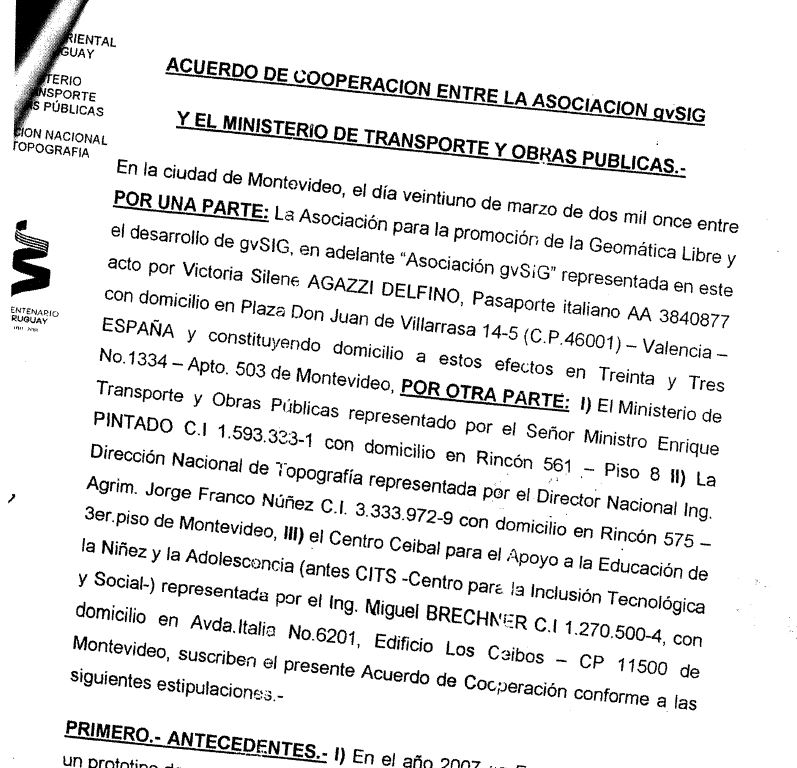
A partir de ahí se plantea una amplia Estrategia de Sostenibilidad:



- difusión internacional: presentaciones en numerosos congresos, artículos en publicaciones extranjeras, participación en proyectos académicos mundiales, exposición en hall de sede de las Naciones Unidas (Nueva York), invitación a ser parte de GeoForAll (Comité de divulgación educativa de la Open Source Geospatial Foundation/OSGeo)
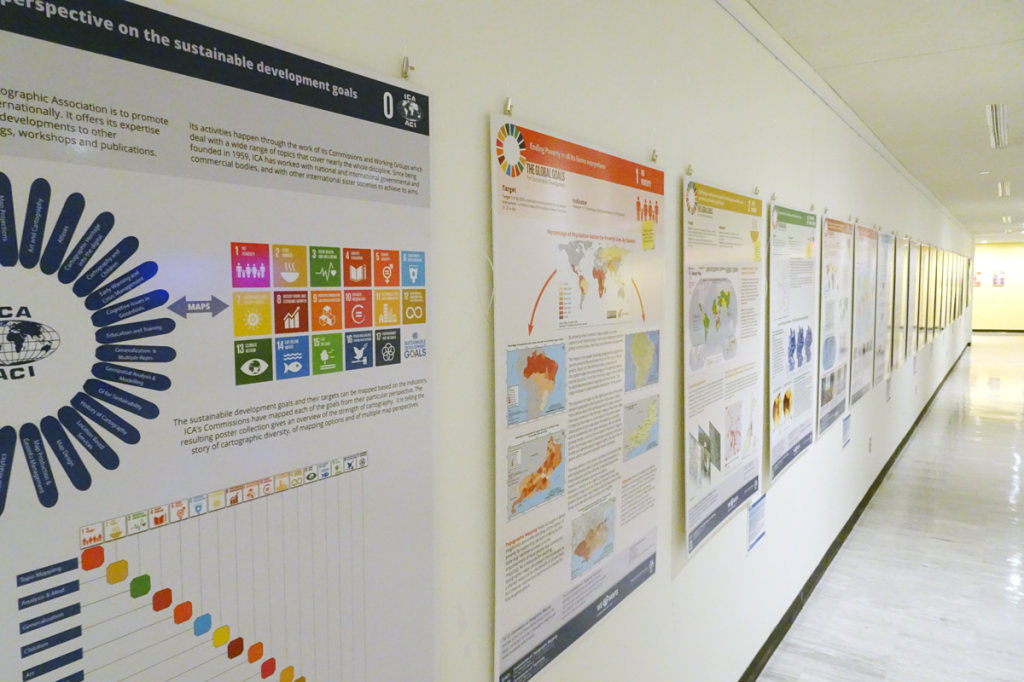 exposición de posters en las Naciones Unidas (Nueva York) en ocasión del International Map Year
exposición de posters en las Naciones Unidas (Nueva York) en ocasión del International Map Year
- talleres nacionales a maestros, profesores, estudiantes de profesorado, estudiantes liceales
- talleres internacionales: España. Perú, Costa Rica
El punto culminante de esta estrategia de sostenibilidad es precisamente el Curso – Concurso Geoalfabetización mediante la utilización de Tecnologías de la Información Geográfica:
- se trata de una iniciativa de cobertura nacional, para grupos de estudiantes -con profesores referentes- de liceos públicos de todo el país
- debido a su impacto fuera de fronteras, se incluye a partir de 2022 la participación de extranjeros
- es organizado por ANEP-DGES (Administración Nacional de Educación Pública-Dirección Nacional de Educación Secundaria), Ceibal y Dir. Nac. de Topografía; en 2023 participa también la Universidad Politécnica de Madrid, colaborando la Gobernación de Cundinamarca (Colombia)
- la primera edición se lleva a cabo en 2017
- este año se desarrolló la sexta edición, siendo la primera vez que participan equipos de otros países de la región (en particular Colombia)
- etapas de la iniciativa:
- lanzamiento: convocatoria a docentes de enseñanza media para participar de una instancia de capacitación y luego en una competición entre proyectos desarrollados por equipos de estudiantes de enseñanza media liderados por un docente
- reclutamiento de tutores para el seguimiento de cada proyecto (hasta 2019 éstos eran estudiantes de las carreras de Cartografía y Agrimensura -UdelaR; a partir de 2021 participan como tutores integrantes de diferentes universidades iberoamericanas del proyecto GeoLIBERO)
- capacitación para docentes y tutores en modalidad b-learning (plataforma + talleres presenciales en todo el país; a partir de 2021, motivados por los cambios impuestos por la pandemia del Covid-19, los talleres son virtuales; a partir de 2022 la capacitación se ofrece también para participantes extranjeros)
- a quienes culminan satisfactoriamente la capacitación se los invita a presentar propuestas de proyectos para participar del concurso
- el Equipo Coordinador sugiere ajustes a dichas propuestas y su traducción a un proyecto
- durante 3 meses aproximadamente, los equipos desarrollan sus proyectos, con espacios virtuales particulares para cada uno en plataforma (para intercambios con tutores y Equipo Coordinador, entrega de materiales solicitados, foros para dudas, preguntas, consultas, comentarios)
- a mitad de tiempo los equipos realizan entregas parciales, presentando avance de cada proyecto y recibiendo la devolución del equipo coordinador y tutores
- al culminar, los equipos defienden sus proyectos ante el jurado, mediante videoconferencia
- luego de las defensas, se procede a emitir el fallo por parte del jurado (a partir de 2021 conformado por referentes expertos internacionales)
- como broche de todo el proceso se realiza un evento de cierre, organizado por Ceibal, en el cual todos los participantes comparten sus proyectos con el resto; se entregan los premios y certificados y se realiza una evaluación general de lo realizado
- reconocimiento internacional: los equipos finalistas reciben un diploma de GeoLIBERO
- videos:
? [https:]]
? [https:]]
? [https:]]
? proyecto premiado en edición 2021: [https:]] - entrevistas:
? [https:]]
? [https:]]
En la edición 2023 resultaron finalistas los siguientes proyectos:
- por Uruguay
- Título: Geo 7°F; Institución: Escuela Técnica N°2 CME; Localidad: Salto; Docente de referencia: Daiana Olivera; Tutor: Romel Vázquez
- Título: Mentes en crecimiento; Institución: Liceo Nº2 Dr. Antonio M. Grompone; Localidad: Salto; Docente de referencia: María Patricia Leal; Tutor: Carlos Lara
- Título: Urbapay; Institución: Liceo Nª4 Manuel Oribe; Localidad: Paysandú; Docente de referencia: Maximiliano Olivera; Tutor: Marino Carhuapoma
- por Colombia
- Título: Turismo, Desarrollo y Medio Ambiente en Choachí; Institución: IED Ignacio Pescador; Localidad: Choachí; Docente de referencia: Astrid Corredor; Tutor: Neftalí Sillero
- Título: Conectando con el Agua: Georreferenciando El «Páramo de Guerrero» en Subachoque y su Importancia Hídrica; Institución: IED La Pradera; Localidad:Subachoque; Docente de referencia: Sandra Milena Diaz Vargas; Tutor: Antoni Pérez Navarro
- Título: Mapeando nuestro territorio: Tabio; Institución: IEDInstituto Tecnico Comercial Jose de San Martin; Localidad: Tabio; Docente de referencia: John Castrillón; Tutor: Nadia Chaer
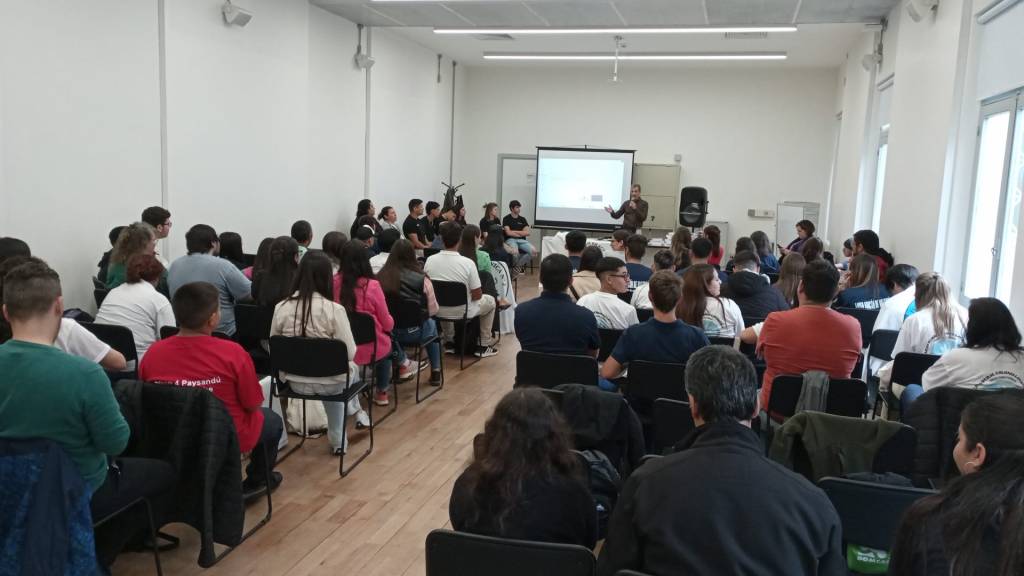 evento de cierre Concurso Proyectos con Estudiantes y gvSIG Batoví 2023
evento de cierre Concurso Proyectos con Estudiantes y gvSIG Batoví 2023
Los proyectos ganadores resultaron los siguientes:
- por Uruguay: proyecto Urbapay
- por Colombia: proyecto Turismo, Desarrollo y Medio Ambiente en Choachí
Actuaron como tutores:
- Neftalí Sillero, Faculdade de Ciências da Universidade do Porto (Portugal)
- Carlos Lara, Facultad de Ciencias de la Universidad Católica de la Santísima Concepción (Chile)
- Marino Carhuapoma, IdeasG (Perú)
- Romel Vázquez, Universidad Central «Marta Abreu» de Las Villas (Cuba)
- Ramon Alejandro Claro Torres, Universidad Central «Marta Abreu» de Las Villas (Cuba)
- A/P Nadia Chaer, Comunidad gvSIG Uruguay (Uruguay)
- Antoni Pérez Navarro, profesor de los Estudios de Informática, Multimedia y Telecomunicación, Universitat Oberta de Catalunya (España)
Los integrantes del jurado fueron:
- Álvaro Anguix – Director de la Asociación gvSIG (España)
- Dr. Luis Manuel Vilches Blázquez – Universidad Politécnica de Madrid (España)
- Efraín Castro – Secretaría de Educación/Gobernación de Cundinamarca (Colombia)
- Prof. Julio A. Rodríguez Vaucher – ANEP/DGETP
- Dr. Gustavo Bentancor– Ceibal
- Insp. Mónica Canaveris – ANEP/DGES
- Sergio Acosta y Lara – DNTop/MTOP
Queremos destacar la calidad de la totalidad de los proyectos presentados, todas excelentes y variadas propuestas, que no hacen más que demostrarnos lo acertada de la iniciativa (el jurado la tuvo muy difícil…). Los trabajos realizados realmente no tienen nada que envidiar a muchos trabajos académicos o los realizados por consultorías. Cada año (y este no ha sido la excepción) muchos proyectos logran impactos tangibles en las comunidades: cambio de recorridos y de frecuencias del transporte colectivo como resultado del análisis y diagnóstico hecho por los estudiantes, pedidos de alcaldes a los estudiantes para asistirlos en la confección de mapas para la Administración, ayuda en la toma de decisiones para una mejor gestión de los residuos de una comunidad, etc., etc. Como se resaltó en el evento de cierre del pasado jueves 7 de diciembre: la iniciativa no sólo contribuye a una mejor capacitación académica de los estudiantes; también ayuda a formar mejores ciudadanos.
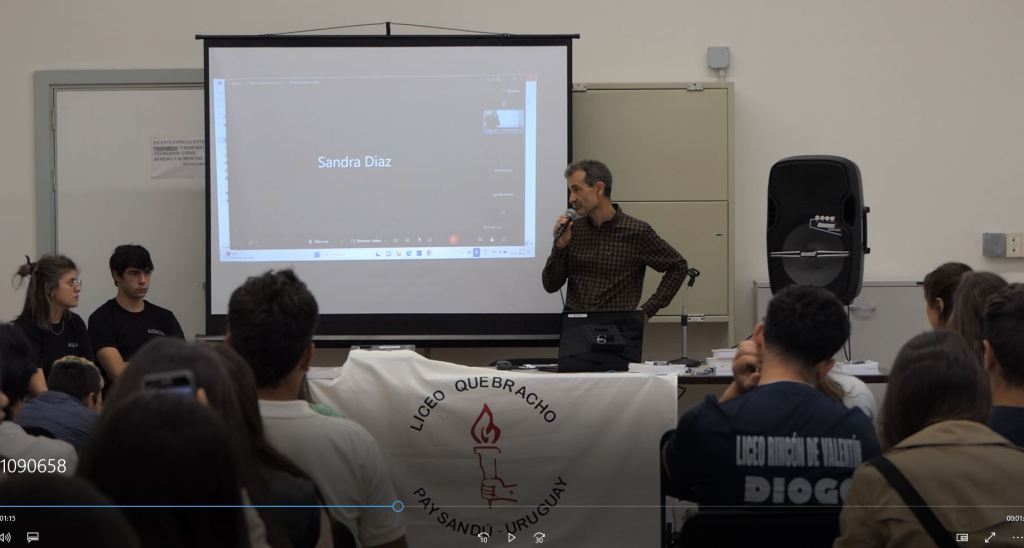 socialización de proyectos
socialización de proyectos
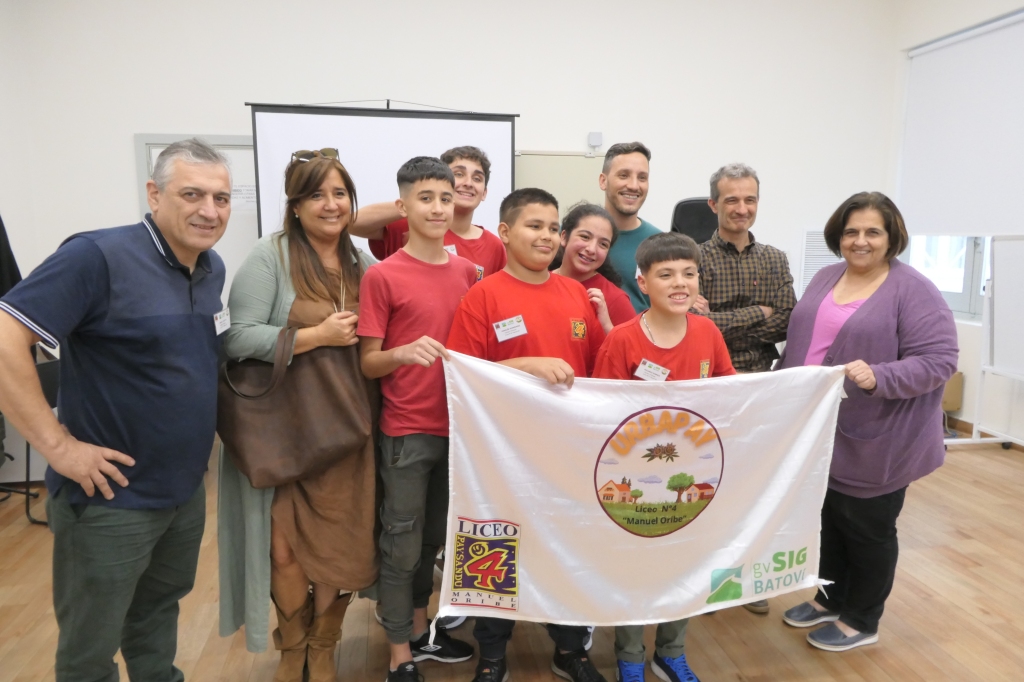 equipo ganador Uruguay
equipo ganador Uruguay
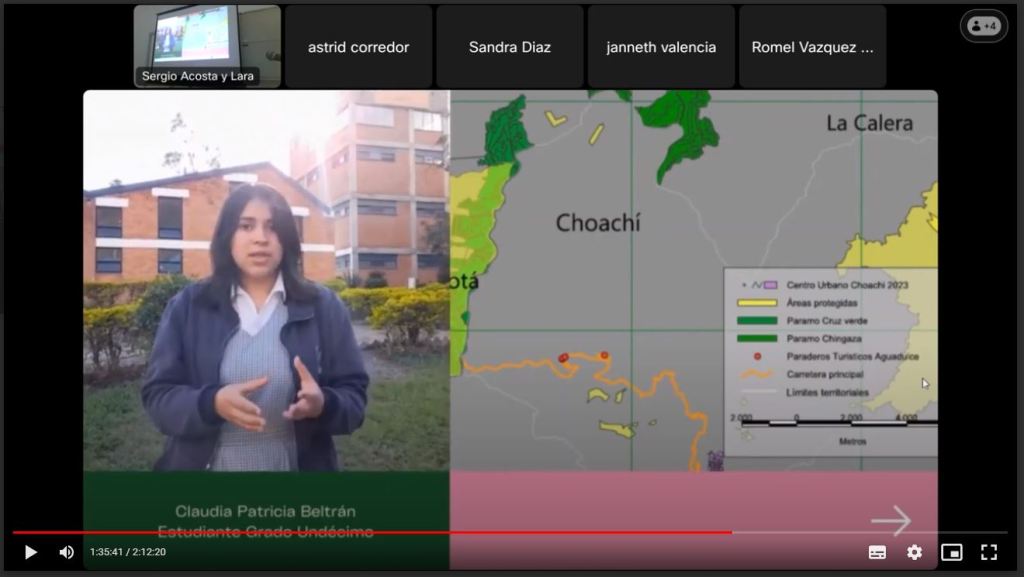 equipo ganador Colombia
equipo ganador Colombia
Desde el Equipo Coordinador queremos volver a agradecer a todas y todos los que nos han apoyado y colaborado con esta iniciativa: a Natalia Pardo, Stephanie Veleda y Daniel Varsi del MTOP (una vez más, un enorme gracias por toda su dedicación, apoyo y por estar siempre en todas); a las y los tutores: un enorme placer haber contado con ustedes; a los integrantes del jurado: nos sentimos muy honrados por su participación; a Martina Bailón, Agostina Bernasconi, Patricia Castell, Carinna Balsamo y Paola Vilar del Plan Ceibal (gracias por su invalorable asistencia); a Álvaro Anguix (coordinador de la red GeoLIBERO), Mario Carrera y toda la Asociación gvSIG (gracias a su incansable apoyo es que este proyecto es posible); a Luis Vilches por su gran apoyo y coordinación internacional, y a todas las autoridades de las instituciones involucradas (nacionales y extranjeras) que han decidido continuar apoyando esta iniciativa, la que continúa creciendo.
-
sur The Carbon Bomb Map
Publié: 11 December 2023, 10:23am CET par Keir Clarke
A 'Carbon bomb' is a large-scale fossil fuel extraction project that has the potential to release massive amounts of carbon dioxide into the atmosphere, thereby significantly contributing to climate change. These massively environmentally damaging projects usually involve the exploitation of oil reserves, coal mines, or natural gas fields. There are currently 425 fossil fuel extraction projects
-
sur From GIS to Remote Sensing: Semi-Automatic Classification Plugin major update: version 8.2.0
Publié: 10 December 2023, 3:12pm CET
The Semi-Automatic Classification Plugin (SCP) has been updated to version 8.2.0 which is focused on the download of new products.This function requires Remotior Sensus to be updated at least to version 0.2.01, which also includes several new products from the Microsoft Planetary Computer. Microsoft Planetary Computer is a platform developed by Microsoft to foster environmental sustainability and Earth science through a Data Catalog, a JupyterHub and several other tools.In this case, Remotior Sensus connects to the Data Catalog to search and download images available from Microsoft Planetary Computer, such as the Landsat archive, MODIS, and Sentinel-2.
Read more » -
sur Free and Open Source GIS Ramblings: Mapping relationships between Neo4j spatial nodes with GeoPandas
Publié: 9 December 2023, 10:33pm CET
Previously, we mapped neo4j spatial nodes. This time, we want to take it one step further and map relationships.
A prime example, are the relationships between GTFS StopTime and Trip nodes. For example, this is the Cypher query to get all StopTime nodes of Trip 17:
MATCH (t:Trip {id: "17"}) <-[:BELONGS_TO]- (st:StopTime) RETURN st
To get the stop locations, we also need to get the stop nodes:
MATCH (t:Trip {id: "17"}) <-[:BELONGS_TO]- (st:StopTime) -[:STOPS_AT]-> (s:Stop) RETURN st ,s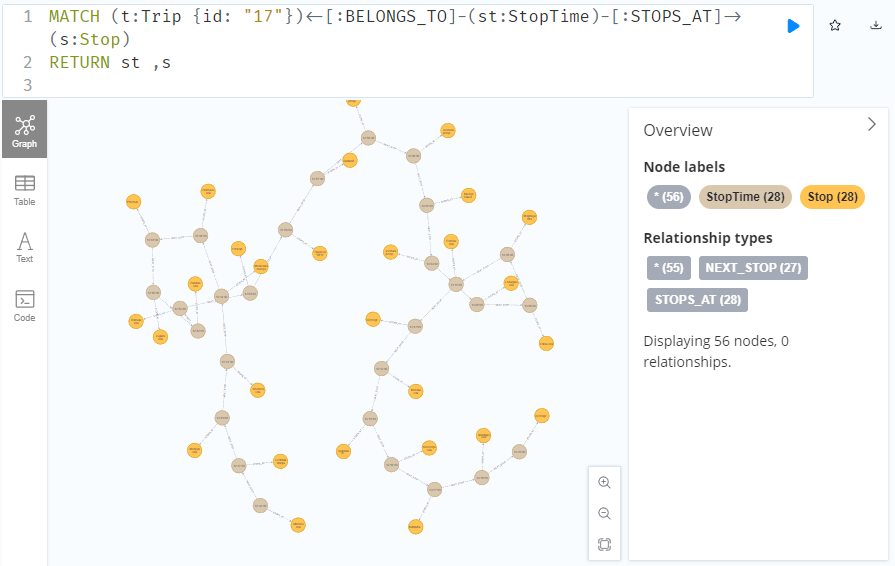
Adapting our code from the previous post, we can plot the stops:
from shapely.geometry import Point QUERY = """MATCH ( t:Trip {id: "17"}) <-[:BELONGS_TO]- (st:StopTime) -[:STOPS_AT]-> (s:Stop) RETURN st ,s ORDER BY st.stopSequence """ with driver.session(database="neo4j") as session: tx = session.begin_transaction() results = tx.run(QUERY) df = results.to_df(expand=True) gdf = gpd.GeoDataFrame( df[['s().prop.name']], crs=4326, geometry=df["s().prop.location"].apply(Point) ) tx.close() m = gdf.explore() m
Ordering by stop sequence is actually completely optional. Technically, we could use the sorted GeoDataFrame, and aggregate all the points into a linestring to plot the route. But I want to try something different: we’ll use the NEXT_STOP relationships to get a DataFrame of the start and end stops for each segment:
QUERY = """ MATCH (t:Trip {id: "17"}) <-[:BELONGS_TO]- (st1:StopTime) -[:NEXT_STOP]-> (st2:StopTime) MATCH (st1)-[:STOPS_AT]->(s1:Stop) MATCH (st2)-[:STOPS_AT]->(s2:Stop) RETURN st1, st2, s1, s2 """ from shapely.geometry import Point, LineString def make_line(row): s1 = Point(row["s1().prop.location"]) s2 = Point(row["s2().prop.location"]) return LineString([s1,s2]) with driver.session(database="neo4j") as session: tx = session.begin_transaction() results = tx.run(QUERY) df = results.to_df(expand=True) gdf = gpd.GeoDataFrame( df[['s1().prop.name']], crs=4326, geometry=df.apply(make_line, axis=1) ) tx.close() gdf.explore(m=m)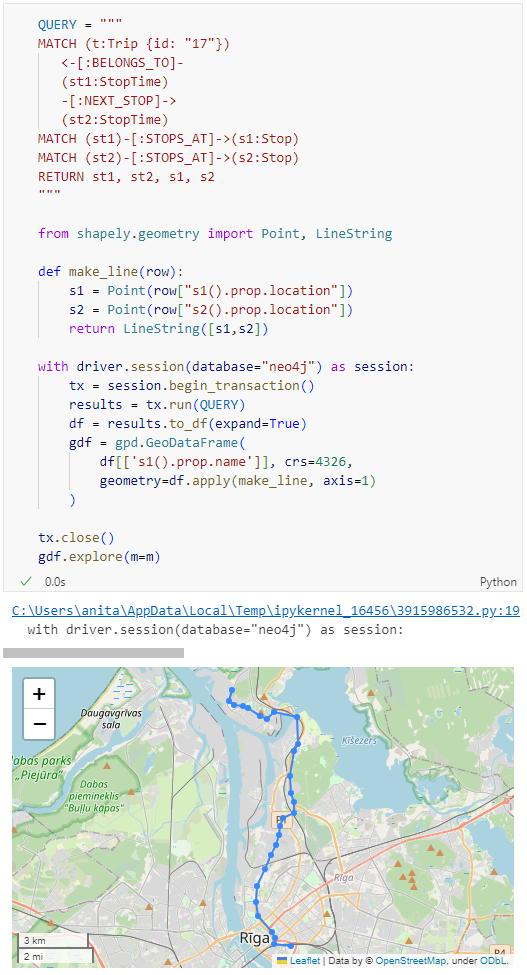
Finally, we can also use Cypher to calculate the travel time between two stops:
MATCH (t:Trip {id: "17"}) <-[:BELONGS_TO]- (st1:StopTime) -[:NEXT_STOP]-> (st2:StopTime) MATCH (st1)-[:STOPS_AT]->(s1:Stop) MATCH (st2)-[:STOPS_AT]->(s2:Stop) RETURN st1.departureTime AS time1, st2.arrivalTime AS time2, s1.location AS geom1, s2.location AS geom2, duration.inSeconds( time(st1.departureTime), time(st2.arrivalTime) ).seconds AS traveltime
As always, here’s the notebook: [https:]]
-
sur Discover Your Neighborhood Tree Score
Publié: 9 December 2023, 10:32am CET par Keir Clarke
The Woodland Trust has released a new interactive map which reveals the amount of tree canopy cover available in thousands of UK neighborhoods. Using the map you can discover the 'tree equity score' of Lower Layer Super Output Area (LSOA) in England, Scotland, Wales and Northern Ireland. If you click on your neighborhood on the Tree Equity Score UK map you can discover its 'tree equity score',
-
sur From GIS to Remote Sensing: Semi-Automatic Classification Plugin update: version 8.1.7
Publié: 8 December 2023, 5:42pm CET
The Semi-Automatic Classification Plugin (SCP) has been updated to version 8.1.7 which solves a few bugs and adds the options to download Sentinel-2 images from the Copernicus Data Space Ecosystem.
Read more »
-
sur Making Animated Map GIFs
Publié: 8 December 2023, 10:51am CET par Keir Clarke
This morning I have been having a lot of fun playing with Darren Wien's new Fly To tool for making animated map GIF's. Using the new Fly To wizard you can easily make your own map fly-thru animations simply by pointing to a starting and ending location on an interactive map. The tool is a great way to create map fly-thru GIFs to illustrate news stories or to enhance blog or social media
-
sur GeoSolutions: DoDIIS 2023 Portland, OR – GeoSolutions USA, Innovation, and Emerging Technology
Publié: 7 December 2023, 7:18pm CET
You must be logged into the site to view this content.
-
sur Is Light Pollution Getting Better?
Publié: 7 December 2023, 11:25am CET par Keir Clarke
David J. Lorenz's Light Pollution Atlas 2006, 2016, 2020 includes global light pollution layers for three different years. It also includes a layer which shows where light pollution around the world has become better or worse during 2014-2020.This 2014-2020 light pollution trend layer shows that light pollution in most of the UK and France and in the eastern U.S. significantly reduced from
-
sur BostonGIS: PostGIS Day 2023 Summary
Publié: 7 December 2023, 3:58am CET
PostGIS Day 2023 videos came out recently. PostGIS Day conference is always my favorite conference of the year because you get to see what people are doing all over the world, and it always has many many new tricks for using PostgreSQL and PostGIS family of extensions you had never thought of. Most importantly it's virtual, which makes it much easier for people to fit in their schedules than an on site conference. We really need more virtual conferences in the PostgreSQL community. Many many thanks to Crunchy Data for putting this together again, in particular to Elizabeth Christensen who did the hard behind the scenes work of corraling all the presenters and stepping in to give a talk herself, and my PostGIS partner in development Paul Ramsey who did the MC'ing probably with very little sleep, but still managed to be very energetic. Check out Elizabeth's summary of the event. Many of her highlights would have been mine too, so I'm going to skip those.
Continue reading "PostGIS Day 2023 Summary" -
sur GeoTools Team: State of GeoTools 30.1
Publié: 6 December 2023, 7:50pm CET
Jody Garnett here to share a presentation from FOSS4G Asia 2023 on the State of GeoTools 30.1. It has been nine years since our last "State of GeoTools" presentation in FOSS4G 2014 Portland; however this was just a lighting talk and is devoted to recent updates. I would like to the event organizers, and my employer GeoCat for the opportunity to speak on behalf of the GeoTools project.
-
sur The Origin of Country Names
Publié: 6 December 2023, 11:49am CET par Keir Clarke
Did you know that Australia got its name from the Latin australis' meaning 'southern', or that Spain derives its name from a small rodent ('España' coming from 'I-Shpania', meaning "island of hyraxes")? Thanks to a new interactive map from Le Monde you can now discover the origin of every country's name in the world. If you hover over a country on the map in the article Discover the origin -
sur Historical Sanborn Maps of America
Publié: 5 December 2023, 10:20am CET par Keir Clarke
From 1866 to 1977 the Sanborn Map Company produced very accurate individual building level maps of U.S. cities and towns. The Sanborn maps provided detailed information about individual city buildings in order to enable fire insurance companies to accurately calculate fire risk. In the 1960s Fire Insurance companies stopped using maps to underwrite fire risk meaning that there was no need to
-
sur Camptocamp: Innovations and Standards in Geospatial
Publié: 5 December 2023, 1:00am CET
Pièce jointe: [télécharger]
At Camptocamp, we are deeply committed to the heart of the open source communities, not just to spur innovation but also to integrate the needs of our clients and partners. -
sur Jorge Sanz: MSF Mapathon at Universitat de València
Publié: 4 December 2023, 12:36pm CET
Last week for the first time since the pandemic I attended a Mapathon in person. With the geomaticblog.net retired, this is my first geospatial post on my own website ?. What’s a mapathon? For those that don’t know the term, a mapathon is a gathering of volunteers to do some remote mapping with the objective of improve the cartography of an area of the world that does not have a proper map. -
sur Jorge Sanz: MSF Mapathon at Universitat de València
Publié: 4 December 2023, 12:36pm CET
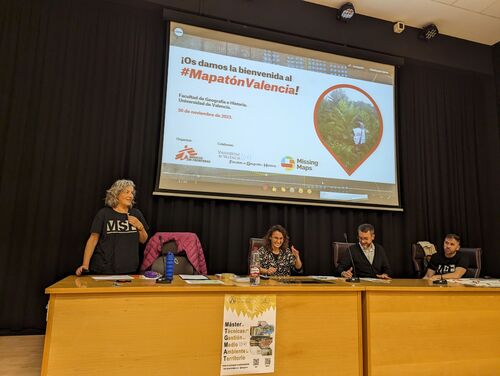 Last week for the first time since the pandemic I attended a Mapathon in person. With the geomaticblog.net retired, this is my first geospatial post on my own website ?.
What’s a mapathon? For those that don’t know the term, a mapathon is a gathering of volunteers to do some remote mapping with the objective of improve the cartography of an area of the world that does not have a proper map.
Last week for the first time since the pandemic I attended a Mapathon in person. With the geomaticblog.net retired, this is my first geospatial post on my own website ?.
What’s a mapathon? For those that don’t know the term, a mapathon is a gathering of volunteers to do some remote mapping with the objective of improve the cartography of an area of the world that does not have a proper map. -
sur Jackie Ng: Announcing: mapguide-rest 1.0 RC6
Publié: 4 December 2023, 11:30am CET
6 years later, I have finally put out another release of mapguide-rest!
The reason for finally putting out a new release (besides being long overdue!), is that I needed a solid verification of the vanilla SWIG API binding work for MapGuide Open Source 4.0 and mapguide-rest was just the ideal project that touches almost every nook and cranny of the MapGuide API. So if mapguide-rest still works with the PHP binding in MapGuide Open Source 4.0, that is as good of an endorsement to the reliability and readiness of these bindings.
For this release of mapguide-rest, it is compatible with the version of PHP that comes with:
- MapGuide Open Source 3.1.2 (PHP 5.6)
- MapGuide Open Source 4.0 Beta 1 (PHP 8.1)
Download
Special thanks to Gordon Luckett and Scott Hamiester for assistance in internal testing of many internal builds of mapguide-rest that finally culminated in this long-overdue release.
Now that this is out of the way, it is back to MapGuide development proper and getting closer to the 4.0 release.
-
sur Global Heating
Publié: 4 December 2023, 10:12am CET par Keir Clarke
In 2023 the Earth's global temperature was 1.05°C warmer than normal. This is extremely alarming as we are quickly approaching what many environmental scientists believe will be the tipping point for global heating. The Intergovernmental Panel on Climate Change (IPCC) has identified 1.5 degrees Celsius of warming above pre-industrial levels as a critical threshold. Beyond this point, the risks
-
sur MapTiler: GeoCamp ES 2023
Publié: 4 December 2023, 1:00am CET
GeoCamp ES is a non-profit, free-to-attend, and self-financed national conference of the international collective Geoinquietos. To talk and learn about earth sciences, open geodata services, free software, and GIS applications, especially around the OSGeo community. -
sur MapTiler: GeoCamp ES 2023
Publié: 4 December 2023, 1:00am CET
GeoCamp ES is a non-profit, free-to-attend, and self-financed national conference of the international collective Geoinquietos. To talk and learn about earth sciences, open geodata services, free software, and GIS applications, especially around the OSGeo community. -
sur From GIS to Remote Sensing: Tutorial: Using Remotior Sensus in Copernicus JupyterLab
Publié: 3 December 2023, 3:50pm CET
 This is a tutorial about Remotior Sensus, a Python package that allows for the processing of remote sensing images and GIS data.
This is a tutorial about Remotior Sensus, a Python package that allows for the processing of remote sensing images and GIS data.
In particular, this tutorial describes the use of Remotior Sensus in Copernicus JupyterLab, which is a Jupyter Notebook service in a web-based environment, offering several tools for working with the Copernicus Data Space.This service can be accessed at this link [https:]] after a free registration to the Copernicus Data Space Ecosystem (CDSE).
The Jupyter Notebooks are available in 3 flavors: Small (2 CPU cores and 4GB RAM), Medium (2 CPU cores and 8GB RAM) and Large (4 CPU cores and 16GB RAM). As stated in the documentation, to ensure the fair use of resources by the CDSE users, it is recommended to start with the Small flavor and switch to a bigger only in case of issues with kernel crashing due to the lack of available memory.
Therefore, the Copernicus JupyterLab offers a great opportunity to use Copernicus data in a cloud environment. In this tutorial, we are going to see how to:- Download and preprocess Sentinel-2 images.
- Create a BandSet and prepare a training input
- Run a Random Forest classification
-
sur Free and Open Source GIS Ramblings: Mapping Neo4j spatial nodes with GeoPandas
Publié: 3 December 2023, 2:31pm CET
In the recent post Setting up a graph db using GTFS data & Neo4J, we noted that — unfortunately — Neomap is not an option to visualize spatial nodes anymore.
GeoPandas to the rescue!
But first we need the neo4j Python driver:
pip install neo4j
Then we can connect to our database. The default user name is
neo4jand you get to pick the password when creating the database:from neo4j import GraphDatabase URI = "neo4j://localhost" AUTH = ("neo4j", "password") with GraphDatabase.driver(URI, auth=AUTH) as driver: driver.verify_connectivity()Once we have confirmed that the connection works as expected, we can run a query:
QUERY = "MATCH (p:Stop) RETURN p.name AS name, p.location AS geom" records, summary, keys = driver.execute_query( QUERY, database_="neo4j", ) for rec in records: print(rec)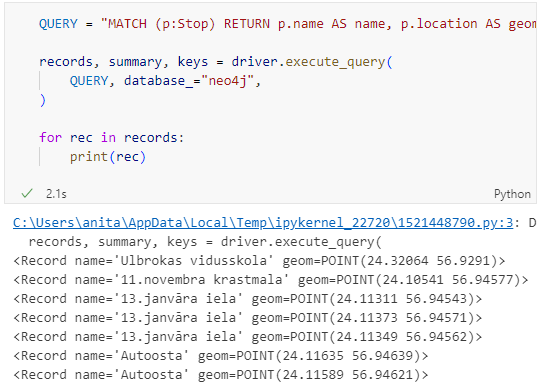
Nice. There we have our GTFS stops, their names and their locations. But how to put them on a map?
Conveniently, there is a to_db() function in the Neo4j driver:
import geopandas as gpd import numpy as np with driver.session(database="neo4j") as session: tx = session.begin_transaction() results = tx.run(QUERY) df = results.to_df(expand=True) df = df[df["geom[].0"]>0] gdf = gpd.GeoDataFrame( df['name'], crs=4326, geometry=gpd.points_from_xy(df['geom[].0'], df['geom[].1'])) print(gdf) tx.close()Since some of the nodes lack geometries, I added a quick and dirty hack to get rid of these nodes because — otherwise —
gdf.explore()will complain about None geometries.

You can find this notebook at: [https:]]
Next step will have to be the relationships. Stay posted.
-
sur Sean Gillies: 2024 Bear 100 registration
Publié: 3 December 2023, 12:19am CET
In my previous post I said that I was going to register for the 2024 Bear 100 and I did. I was logged into UltraSignup promptly at 8 am on Friday and am glad, because this race apparently filled up within the day. 2024, let's fucking go!

Brunch at Upper Richards Hollow, 2023-09-29
-
sur From GIS to Remote Sensing: Tutorial: Random Forest Classification Using Remotior Sensus
Publié: 2 December 2023, 3:54pm CET
 This is a tutorial about Remotior Sensus, a Python package that allows for the processing of remote sensing images and GIS data.In the last few months Remotior Sensus was frequently update to fix and integrate new functions, in particular for the integration with the Semi-Automatic Classification Plugin for QGIS.
This is a tutorial about Remotior Sensus, a Python package that allows for the processing of remote sensing images and GIS data.In the last few months Remotior Sensus was frequently update to fix and integrate new functions, in particular for the integration with the Semi-Automatic Classification Plugin for QGIS.
In this tutorial we are going to use Remotior Sensus to perform the Random Forest classification of a Copernicus Sentinel-2 image, which involves the following main steps:- Create a BandSet using an image
- Load a training input
- Perform the random forest classification
-
sur QGIS Blog: Plugin Update Sept-Nov 2023
Publié: 2 December 2023, 11:44am CET
This autumn, from September to November, 84 new plugins have been published in the QGIS plugin repository.
Here’s the quick overview in reverse chronological order. If any of the names or short descriptions piques your interest, you can find the direct link to the plugin page in the table below:
SOSIexpressions Expressions related to SOSI-data Puentes Run external Python files inside QGIS. UA CRS Magic ?????? ??????? ???????? ??? ?????????? ???? FilterMate FilterMate is a Qgis plugin, a daily companion that allows you to easily explore, filter and export vector data QWC2_Tools QGIS plug-in designed to publish and manage the publication of projects in a QWC2 instance. The plugin allows you to publish projects, delete projects and view the list of published projects. QGIS Fast Grid Inspection (FGI) This plugin aims to allow the generation and classification of samples from predefined regions. QDuckDB This plugin adds a new data prodivder that can read DuckDB databases and display their tables as a layer in QGIS. CIGeoE Toggle Label Visibility Toggle label visibility CIGeoE Merge Areas Centro de Informação Geoespacial do Exército Drainage the hydro DEM analysis with the TauDEM Postcode Finder The plugin prompts the user to select the LLPG data layer from the Layers Panel and enter a postcode. The plugin will search for the postcode, if found, the canvas will zoom to all the LLPG points in the postcode. Multi Union This plugin runs the UNION MULTIPLE tool, allowing you to use up to 6 polygon vector layers simultaneously. FLO-2D MapCrafter This plugin creates maps from FLO-2D output files. Download raster GEE download_raster_gee GisCarta Manage your GisCarta data TENGUNGUN To list up and download point cloud data such as “VIRTUAL SHIZUOKA” LADM COL UV Plugin de Qgis para la evaluación de calidad en el proceso de captura y mantenimiento de datos conformes con el modelo LADM-COL ohsomeTools ohsome API, spatial and temporal OSM requests for QGIS Social Burden Calculator This plugin calculates social burden Show Random Changelog Entry on Launch Shows a random entry in the QGIS version’s visual changelog upon QGIS launch Fotowoltaika LP Wyznaczanie lokalizacji pod farmy fotowoltaiczne LP KICa – KAN Imagery Catalog KICa, is QGIS plugin Kan Imagery Catalog, developed by Kan Territory & IT to consult availability of images in an area in an agnostic way, having as main objective to solve the need and not to focus on suppliers. In the beginning, satellite imagery providers (free and commercial) are incorporated, but it is planned to incorporate drone imagery among others. Risk Assessment Risk assessment calculation for forecast based financing ViewDrone A QGIS plugin for viewshed analysis in drone mission planning qgis2opengis Make Lite version of OpenGIS – open source webgis Quick Shape Update Automatic update of the shapes length and/or area in the selected layer CoolParksTool This plugin evaluates the cooling effect of a park and its impact on buildings energy and thermal comfort Nahlížení do KN Unofficial integration for Nahlížení do Katastru nemovitostí. PyGeoRS PyGeoRS is a dynamic QGIS plugin designed to streamline and enhance your remote sensing workflow within the QGIS environment. D4C Plugin This plugin allows the manbipulation from QGis of Data4Citizen datasets (Open Data platform based on Drupal and CKan) Avenza Maps’s KML/KMZ File Importer This plugin import features from KML e KMZ files from Avenza Maps Histogram Matching Image histogram matching process PV Prospector Displays the PV installation potential for residential properties. The pv_area layer is derived from 1m LIDAR DSM, OSMM building outlines and LLPG data. Save Attributes (Processing) This plugin adds an algorithm to save attributes of selected layer as a CSV file Artificial Intelligence Forecasting Remote Sensing This plugin allows time series forecasting using deep learning models. Salvar Pontos TXT Esse plugin salvar camada de pontos em arquivo TXT QGIS to Illustrator with PlugX The plugin to convert QGIS maps to import from Illustrator. With PlugiX-QGIS, you can transfer maps designed in QGIS to Illustrator! QCrocoFlow A QGIS plugin to manage CROCO projectsqcrocoflow Soft Queries This plugin brings tools that allow processing of data using fuzzy set theory and possibility theory. TerrainZones This Plugin Identifies & Creates Sub-Irrigation Zones Consolidate Networks Consolidate Networks is a a Qgis plugin bringing together a set of tools to consolidate your network data. AWD Automatic waterfalls detector SAGis XPlanung Plugin zur XPlanung-konformen Erfassung und Verwaltung von Bauleitplänen Monitask a SAM (facebook segment anything model and its decendants) based geographic information extraction tool just by interactive click on remote sensing image, as well as an efficient geospatial labeling tool. PLATEAU QGIS Plugin Import the PLATEAU 3D City Models (CityGML) used in Japan — PLATEAU 3D??????CityGML?????QGIS??????? FLO-2D Rasterizor A plugin to rasterize general FLO-2D output files. Geoportal Lokalizator PL: Wtyczka otwiera rz?dowy geoportal w tej samej lokacji w której u?ytkownik ma otwarty canvas QGIS-a. EN: The plugin opens the government geoportal in the same location where the user has the QGIS canvas open (Poland only). BorderFocus clicks on the edge center them on the canvas LANDFILL SITE SELECTION LANDFILL SITE SELECTION Bearing & Distance This plugin contains tools for the calculation of bearing and distances for both single and multiple parcels. Moisture and Water Index 2.0 Este complemento calcula el índice NDWI con las imágenes del Landsat 8. K-L8Slice Este nombre combina el algoritmo k-means que se utiliza para el agrupamiento (K) con “Landsat 8”, que es el tipo específico de imágenes satelitales utilizadas, y “Slicer”, que hace referencia al proceso de segmentación o corte de la imagen en diferentes clusters o grupos de uso del suelo. EcoVisioL8 Este complemento fue diseñado para automatizar y optimizar la obtención de índices SAVI, NDVI y SIPI, así como la realización de correcciones atmosféricas en imágenes Landsat 8. QGIS Animation Workbench A plugin to let you build animations in QGIS Catastro con Historia Herramienta para visualizar el WMS de Catastro en pantalla partida con historia. RechercheCommune Déplace la vue sur l’emprise de la commune choisie. Sentinel2 SoloBand Sentinel2 SoloBand is a plugin for easily searching for individual bands in Sentinel-2 imagery. CIGeoE Right Angled Symbol Rotation Right Angled Symbol Rotation CIGeoE Node Tool Tool to perform operations over nodes of a selected feature, not provided by similar tools and plugins. Spatial Distribution Pattern This plugin estimates the Spatial Distribution Pattern of point and linear features. Webmap Utilities This plugin provides tools for clustered and hierarchical visualization of vector layers, creation of Relief Shading and management of scales using zoom levels. Simstock QGIS Allows urban building energy models to be created and simulated within QGIS Fast Point Inspection Fast Point Inspection is a QGIS plugin that streamlines the process of classifying point geometries in a layer. Layer Grid View The Layer Grid Plugin provides an intuitive dockable widget that presents a grid of map canvases. Kadastr.Live Toolbar ????? ??????? ?? ????? Kadastr.Live ?? ??????????? ???????. S+HydPower Plugin designed to estimate hydropower generation. QollabEO Collaborative functions for interaction with remote users. digitizer digitizer NetADS NetADS est un logiciel web destiné à l’instruction dématérialisée des dossiers d’urbanisme. Runoff Model: RORB Build a RORB control vector from a catchment FlexGIS Manage your FlexGIS data LXExportDistrict Export administrative district PostGIS Toolbox Plugin for QGIS implementing selected PostGIS functions Chasse – Gestion des lots Fonctions permettant de définir la surface cadastrale des lots de chasse et d’extraire la liste des parcelles concernées par chaque lot de chasse, sous forme de fichier Excel®. Time Editor Used to facilitate the editing of features with lifespan information RST This plugin computes biophysical indices Japanese Grid Mesh Create common grid squares used in Japan. ???????????????????????????????????????????????????????????????????CSV???????????????????????????????????????? Panoramax Upload, load and display your immersive views hosted on a Panoramax instance. StereoPhoto Permet la visualisation d’images avec un système stéréoscopique CIGeoE Merge Multiple Lines Merge multiple lines by coincident vertices and with the same attribute names and values. CIGeoE Merge Lines Merge 2 lines that overlap (connected in a vertex) and have same attribute names and values. Nimbo’s Earth Basemaps Nimbo’s Earth Basemaps is an innovative Earth observation service providing cloud-free, homogenous mosaics of the world’s entire landmass as captured by satellite imagery, updated every month. OpenHLZ An Open-source HLZ Identification Processing Plugin Selection as Filter This plugin makes filter for the selected features
-
sur Sea Level Rise Maps
Publié: 2 December 2023, 10:06am CET par Keir Clarke
Darren Wiens' new Sea Level Rise Simulation map shows how rising sea levels might effect coastlines around the world. Using the simulator you can adjust the height of the sea around the world to see what level of global heating will turn your town into the next Atlantis.Darren's map uses AWS Terrain Tiles with Mapbox GL's raster-value expression to visualize global sea levels. In very simple -
sur The Live Music Mapping Project
Publié: 1 December 2023, 10:21am CET par Keir Clarke
The combination of the Covid epidemic, inner-city gentrification and austerity has had a hugely negative impact on live music venues and the live music networks of many cities. The Live Music Mapping Project has been launched to help overcome these challenges by creating detailed maps of the local live ecosystem in individual cities. Currently the project has released interactive maps for seven
-
sur How OGC Contributes to FAIR Geospatial Data
Publié: 30 November 2023, 6:39pm CET par Simon Chester
Standards are a key element of the FAIR Principles of Findability, Accessibility, Interoperability, and Reusability. As such, the Open Geospatial Consortium (OGC) has been supporting the FAIR Principles for geospatial information since its formation 30 years ago.
Following the more recent codification of the FAIR principles, the growing recognition of their potential to improve data production, storage, exchange, and processing is seeing them being used to support and enhance recent technological developments such as artificial intelligence, crowdsourcing, data spaces, digital twins, cloud computing, and beyond. This blog post, therefore, offers an overview of select OGC standards and components that support FAIRness in geospatial data.
Within the whole OGC Standards suite, we can broadly distinguish two types of Standards: data format and transfer standards that facilitate data exchange between systems; and semantic interoperability standards that support a common understanding of the meaning of data. For example, OGC Standards that define interoperable geometrical information formats, such as 3D Tiles, GML, GeoPackage, GeoTiff, or KML, support FAIRness by facilitating data Access and Reuse.
Communication Standards
Starting with OGC Web Map Service (WMS) 1.0 in 2000, the suite of OGC Web Services Standards grew to become OGC’s most popular and successful suite of Standards. Services that implement OGC Web Services Standards give access to different kinds of data through the web. Most OGC Web Services provide instructions on how to post a message or build a query URL that gives access to the data behind the service. The URL contains an action to perform and parameters to modify the action and specify the form of the result.
While perfectly functional, the OGC Web Services Standards do not completely follow modern practices on the Web. In particular they do not focus on resources but on operations. To correct that issue, the OGC is evolving the OGC Web Services into the OGC APIs – open web APIs that define resources and use HTTP methods to retrieve them. OGC APIs have diverse functionalities, as explained below.
Communication Standards for Finding DataThe Catalog Service for the Web (CSW) is an OGC Web Service that provides the capacity to query a collection of metadata and find the data or the services that the user requires. Deploying a CSW (e.g. a GeoNetwork instance) is a way to comply with the FAIR sub-principle “F4. (Meta)data are registered or indexed in a searchable resource.” CSW is compatible with Dublin Core and ISO 19115 metadata documents. An interesting characteristic of the GeoNetwork is its capability to store attachments to the metadata. This provides a way to store the actual data as an attachment and link it to the distribution section of an ISO 19115. This ensures not only Findability of the metadata but also Findability of the data. In the Open Earth Monitor (OEMC) project, CSW can be effectively used to store metadata about the in-situ data and some of the results of the pilots, making them Findable on the web. The original Remote Sensing data is offered through a SpatioTemporal Asset Catalog (STAC).
The OGC API – Records Standard is an alternative to CSW that uses the aforementioned resource-oriented architecture. It gives a URL to each and every metadata/data record stored in the catalog, making it compliant with the FAIR sub-principle “F1. (Meta)data are assigned a globally unique and persistent identifier.” The OGC API – Records Standard is still in its draft phase and the authors are making efforts to exploit STAC good practices and make the two compatible.
For flexibility, in the CSW and OGC API – Records Standards, a metadata record is not obligatory, though it is desirable in many cases. This is useful for improved findability, but also for preservation purposes when the dataset may no longer be available. This ensures compatibility with the FAIR sub-principle “A2. Metadata are accessible, even when the data are no longer available.”
Communication Standards for Accessing DataThe OGC Web Feature Service (WFS) and the Web Coverage Service (WCS) give access to feature or coverage data independently of the data’s data model or schema. Implementations of these services are based on Open Standards that can be implemented for free. This complies with the FAIR sub-principle “A1.1 The protocol is open, free, and universally implementable.” It is possible to get the whole resource or a subset of it based on spatial or thematic queries. However, these services are based on a service-oriented architecture and do not necessarily provide a URI for each resource.
The newer OGC API – Features and OGC API – Coverages Standards, though, provide similar functionality with a resource-oriented architecture. They provide a URI for each resource they expose. This makes the OGC API Standards, as well as the SensorThings API, compliant to the FAIR sub-principle “A1. (Meta)data are retrievable by their identifier using a standardized communications protocol.” OGC Web Services and OGC APIs both use the HTTP protocol over the Internet and can make use of the current standards and practices for authentication and authorization, such as OpenID Connect.
However, the resource-oriented architecture of the OGC API Standards means they are better positioned to adopt best practices for authentication and authorization. In this paradigm, authorization on geospatial resources can be fine-tuned for each resource URI in the same way as any other resource on the Web. As such, OGC API – Features, OGC API – Coverages, and The Sensor Things API comply with the FAIR sub-principle “A1.2 The protocol allows for an authentication and authorization procedure, where necessary.”
Semantic Interoperability Standards The OGC RAINBOW
The OGC RAINBOW
To better support the “Interoperable” FAIR principle as it applies semantic interoperability, OGC is implementing the OGC RAINBOW (formerly the OGC Definitions Server) as a Web accessible source of information about concepts and vocabularies that OGC defines or that communities ask the OGC to host on their behalf. It applies FAIR principles to the key concepts that underpin interoperability in systems using OGC specifications.
The OGC Registry for Accessible Identifiers of Names and Basic Ontologies for the Web (RAINBOW) is a linked-data server, published and maintained by OGC, used to manage and publish reference vocabularies, standard definitions with profiles, ontologies, and resources. It is intended to be a node in an interoperable ecosystem of resources published by different communities. It supports a wide spectrum of resources and allows more value to be realized from data. It can be accessed at opengis.net/def.
OGC RAINBOW is implemented using Linked Data principles that provide enhanced findability, making it compliant with the FAIR sub-principles “F1. (Meta)data are assigned a globally unique and persistent identifier” and “F4: (Meta)data are registered or indexed in a searchable resource.” It is accessed using the HTTP protocols over the Internet, so is also compliant with “A1. (Meta)data are retrievable by their identifier using a standardised communication protocol” and “A1.1 The protocol is open, free, and universally implementable.”
The set of concepts stored in the RAINBOW or in other vocabularies can be used by data and metadata to comply with the FAIR sub-principles “I1. (Meta)data use a formal, accessible, shared, and broadly applicable language for knowledge representation” and “I2. (Meta)data use vocabularies that follow FAIR principles.”
The OGC SensorThings APIThe OGC SensorThings API is an open and free standard that complies to the FAIR sub-principle “A1.1 The protocol is open, free, and universally implementable.” It incorporates a data model that includes two properties that allow for linking to URLs for “units of measurement” and “observed properties” (e.g. references to variable definitions) that makes it compliant with the FAIR sub-principle “I2. (Meta)data use vocabularies that follow FAIR principles.” However, other services and APIs, such as OGC API – Features and OGC API – Coverages, do not specify how this could be done in practice, so more work needs to be done in that respect.
On the other hand, the new OGC APIs use link mechanisms to connect datasets, resources, and resource collections to other resources for different purposes, making them compliant with the FAIR sub-principle “I3 (Meta)data include qualified references to other (meta)data.”
Similarly, the new OGC SensorThings API plus (STAplus) Standard includes an additional element called “Relation” that allows for relating an observation to other internal or external observations. It also adds an element called “License” associated with the datastream or observation group that complies with the FAIR sub-principle “R1.1. (Meta)data are released with a clear and accessible data usage license.” Further, the STA data model can be extended to domain-specific areas by subclassing some of the entities, such as “Thing” and “Observation,” allowing it to meet the FAIR sub-principle “R1.3. (Meta)data meet domain-relevant community standards.”
STAplus includes many considerations for secure operations and can support authentication and authorization through the implementation of business logic, making it compliant with the FAIR sub-principle “A1.2. The protocol allows for an authentication and authorization procedure where necessary.”
Other Standard Thematic Data ModelsOGC also offers Standards that define thematic data models and knowledge representations. For example, WaterML is an information model for the representation of water observations data. In addition, PipelineML defines concepts supporting the interoperable interchange of data pertaining to oil and gas pipeline systems. The PipelineML Core addresses two critical business use-cases that are specific to the pipeline industry: new construction surveys and pipeline rehabilitation.
Another example is the Land and Infrastructure Conceptual Model (LandInfra) for land and civil engineering infrastructure facilities. Subject areas include facilities, projects, alignment, road, railway, survey, land features, land division, and “wet” infrastructure (storm drainage, wastewater, and water distribution systems). CityGML is intended to represent city objects in 3D city models. The (upcoming) Model for Underground Data Definition and Integration (MUDDI) represents information about underground utilities. IndoorGML offers a data model to represent indoor building features. Finally, GeoSciML is a model of geological features commonly described and portrayed in geological maps, cross sections, geological reports and databases. This standard describes a logical model for the exchange of geological map data, geological time scales, boreholes, and metadata for laboratory analyses.
The existence of these Standards can help each thematic sector to comply with the FAIR Interoperability sub-principle “I1. (Meta)data use a formal, accessible, shared, and broadly applicable language for knowledge representation.” As well as these standards, connecting their vocabularies to information systems or databases would significantly increase their usefulness and encourage the principle of Reusability “R1.(Meta)data are richly described with a plurality of accurate and relevant attributes” and sub-principle “R1.3 (Meta)data meet domain-relevant community standards.”
FAIR in Everything We DoOGC’s Mission, to “Make location information Findable, Accessible, Interoperable, and Reusable (FAIR),” places the FAIR Principles at the heart of everything we do. This post has shown how OGC Standards explicitly address the FAIR Principles to contribute to FAIR geospatial data.
The Standards shown here were chosen due to their popularity and utility, but represent only a small portion of what’s available from OGC. You can see the full suite of OGC Standards at ogc.org/standards.
For more detailed information on OGC API Standards, including developer resources, news of upcoming code sprints, or to learn how the family of OGC API Standards work together to provide modular “building blocks for location” that address both simple and the most complex use-cases, visit ogcapi.org.
The post How OGC Contributes to FAIR Geospatial Data appeared first on Open Geospatial Consortium.
-
sur The Most Popular Music in Your Town
Publié: 30 November 2023, 10:24am CET par Keir Clarke
SZA's Kill Bill was the most listened to song in New York and San Francisco this year. In Denver and New Orleans the most listened to song was Morgan Wallen's Last Night. While Eslabon Armado y Peso Pluma's Ella Baila Sola was the most popular tune in Los Angeles, Houston and San Diego.Spotify has released a new interactive map which reveals the most listened to songs in cities around the world
-
sur GeoServer Team: GeoServer installation methods on Windows
Publié: 30 November 2023, 1:00am CET
GeoSpatial Techno is a startup focused on geospatial information that is providing e-learning courses to enhance the knowledge of geospatial information users, students, and other startups. The main approach of this startup is providing quality, valid specialized training in the field of geospatial information.
( YouTube | LinkedIn | Facebook | Reddit | X )
GeoServer installation methods: “Windows Installer” and “Web Archive”GeoServer installation methods: “Windows Installer” and “Web Archive” In this session, we will talk about how to install GeoServer software by two common methods in Windows. If you want to access the complete tutorial, simply click on the link.
IntroductionGeoServer can be installed on different operating systems, since it’s a Java based application. You can run it on any kind of operating system for which exists a Java virtual machine. GeoServer’s speed depends a lot on the chosen Java Runtime Environment (JRE). The latest versions of GeoServer are tested with both OracleJRE and OpenJDK. These versions are:
- Java 17 for GeoServer 2.23 and above
- Java 11 for GeoServer 2.15 and above
- Java 8 for GeoServer 2.9 to GeoServer 2.22
- Java 7 for GeoServer 2.6 to GeoServer 2.8
- Java 6 for GeoServer 2.3 to GeoServer 2.5
- Java 5 for GeoServer 2.2 and earlier
But remember that the older versions are unsupported and won’t receive fixes nor security updates, and contain well-known security vulnerabilities that have not been patched, so use at own risk. That is true for both GeoServer and Java itself.
There are many ways to install GeoServer on your system. This tutorial will cover the two most commonly used installation methods on Windows.
- Windows Installer
- Web Archive
The Windows installer provides an easy way to set up GeoServer on your system, as it requires no configuration files to be edited or command line settings.
Installation- GeoServer requires a Java environment (JRE) to be installed on your system, available from Adoptium for Windows Installer, or provided by your OS distribution. For more information, please refer to this link: [https:]
Consider the operating system architecture and memory requirements when selecting a JRE installer. 32-bit Java version is restricted to 2 GB memory, while the 64-bit version is recommended for optimal server memory. Utilizing JAI with the 32-bit JRE can enhance performance for WMS output generation and raster operations.
- Install JRE by following the default settings and successfully complete the installation.
- Navigate to the GeoServer.org and download the desired version of GeoServer.
- Launch the GeoServer installer and agree to the license.
- Enter the path to the JRE installation and proceed with the installation. The installer will attempt to automatically populate this box with a JRE if it is found, but otherwise you will have to enter this path manually.
- Provide necessary details like the GeoServer data directory, administration credentials, and port configuration.
- Review the selections, install GeoServer, and start it either manually or as a service.
- Finally, navigate to localhost:8080/geoserver (or wherever you installed GeoServer) to access the GeoServer Web administration interface.
GeoServer can be uninstalled in two ways:
- By running the uninstall.exe file in the directory where GeoServer was installed
- By standard Windows program removal
GeoServer is packaged as a web-archive (WAR) for use with an application server such as Apache Tomcat or Jetty. It has been mostly tested using Tomcat, and so is the recommended application server. There are reasons for installing it such as it is widely used, well-documented, and relatively simple to configure. GeoServer requires a newer version of Tomcat (7.0.65 or later) that implements Servlet 3 and annotation processing. Other application servers have been known to work, but are not guaranteed.
Installation- Make sure you have a JRE installed on your system, then download Apache Tomcat from its website [https:] For the Windows installation package, scroll down and choose the 32bit/64bit Windows Service Installer option.
- Configure Tomcat by selecting components, setting up a username and password, and specifying memory settings. So, before start the Tomcat service, you have to configure the memory settings that will use for Java VM. To do it, open the Tomcat9w from the bin folder, then click on the Java tab. This tab allows for configuration of memory settings, including initial and maximum memory pool sizes. Recommended values are 512MB for the initial memory pool and 1024MB for the maximum memory pool.
- Start Tomcat service and verify its functionality, then navigate to localhost:8080, and get the Tomcat9 web page.
- Navigate to the GeoServer.org and Download page. Select Web Archive on the download page from the version of GeoServer that you wish to download.
- Deploy the GeoServer web archive as you would normally. Often, all that is necessary is to copy the GeoServer.war file to the Tomcat’s webapps directory, then the application will be deployed automatically.
- Now to access the Web administration interface, open a browser and navigate to localhost:8080 and press Manager App button. Enter the username and password of apache tomcat. Click on the start button for the GeoServer. Once it has started, click the GeoServer link. This will take you to the GeoServer web page.
Stop the container application. Remove the GeoServer webapp from the container application’s webapps directory. This will usually include the GeoServer.war file as well as a GeoServer directory.
Difference between GEOSERVER.war and GEOSERVER.exe?- The ‘GeoServer.exe’ NSIS installer registers GeoServer as a Windows Service, which uses the Jetty application server to run GeoServer. The ‘GeoServer.war’ is a platform independent web-archive package to be deployed in your own application server (we recommend Apache Tomcat). Using the ‘GeoServer.exe’ installer is a reliable way to setup GeoServer as a windows background service. The downside is the included Jetty application server is managed using text files (jetty.ini) once installed.
- Use of ‘GeoServer.war’ web-archive is provided to install into your own application server (we recommend Apache Tomcat as the market leader, with excellent documentation and integration options). A single application server may support several web application allowing GeoServer to be run alongside your own java web application.
-
sur Locking Up Louisiana
Publié: 29 November 2023, 11:34am CET par Keir Clarke
The state of Louisiana likes putting its citizens in jail. Nearly 1 in every 100 Louisiana residents are locked up in a state prison or local jail. The reasons for Louisiana's high incarceration rates are simple. It isn't because Louisiana is full of criminals. It is because of racism and the profits to be made from enforced slave labor.I arrived at this conclusion after reading the Vera
-
sur Marco Bernasocchi: New QGIS Courses dates for 2024
Publié: 29 November 2023, 11:03am CET
We published our new dates for all courses in 2024 and are looking forward to your participation

- Cours QGIS de base, 10.01. et 17.01.2024 à Lausanne in French
- Cours QGIS avancé, 24.01. et 31.01.2024 à Lausanne in French
- INTERLIS Webinar, 07.03.24 Online in German
- Modelbaker Kurs, 14.03.24 in Zürich in German
- QGIS Kurs Einsteiger, 22.05 und 29.05.2024 in Zürich in German
- QGIS Kurs Fortgeschrittene, 05.06 und 12.06.2024 in Zürich in German
- QGIS Kurs Einsteiger, 30.10 und 06.11.2024 in Bern in German
- QGIS Kurs Fortgeschrittene, 13.11 und 20.11.2024 in Bern in German
- QGIS Kurs Fortgeschrittene, 13.11 und 20.11.2024 in Bern in German
You can find all course information by clicking on the corresponding link
Subscribe now -
sur Free and Open Source GIS Ramblings: Analyzing mobility hotspots with MovingPandas & CARTO
Publié: 28 November 2023, 6:57pm CET
Today, I want to point out a blog post over at
written together with my fellow co-authors and EMERALDS project team members Argyrios Kyrgiazos and Helen McKenzie.

In this blog post, we walk you through a trajectory hotspot analysis using open taxi trajectory data from Kaggle, combining data preparation with MovingPandas (including the new OutlierCleaner illustrated above) and spatiotemporal hotspot analysis from Carto.
-
sur gvSIG Team: Free workshop on ‘Introduction to gvSIG,’ using version 2.6 and its new icon set at 19th gvSIG Conference
Publié: 28 November 2023, 3:47pm CET
On November 30, 2023, during the 19th International gvSIG Conference, a free workshop will be held to learn to use version 2.6 of gvSIG, showcasing the new icon set.
To participate in the workshop, simply register using the following link: Workshop Registration.

Version 2.6 comes with an improved default icon set, replacing the one used since its initial versions.
This workshop will cover the main tools of the application, creating views, loading vector and raster layers, both locally and remotely, editing them graphically and alphanumeric, applying geoprocessing, and creating maps. All of this will be done using the new icon set, providing a refreshed version of gvSIG.
Whether you’ve used gvSIG before or it’s your first time, you won’t want to miss this workshop.
To follow it, you’ll need to download the portable version 2.6 of gvSIG for your operating system: Windows 64 – Windows 32 – Linux 64 – Linux 32
You’ll have to extract it to a folder without spaces. For example, you can create a folder called ‘gvSIG’ in C:\ (on Windows) or in the user’s home directory (on Linux), place the zip file inside, and extract it there.
You’ll also need to download the cartography to be used: Workshop Cartography ‘Introduction to gvSIG 2.6’
-
sur The Live Amtrak Train Map
Publié: 28 November 2023, 1:30am CET par Keir Clarke
Trains.fyi is a live interactive map which shows the real-time locations of passenger trains in the U.S. and Canada. The map uses colored markers to show the near real-time positions of trains from a number of different train companies in North America. The arrow on the markers show a train's direction of travel and the colors indicate the transit operators of individual trains. If you
-
sur GeoTools Team: GeoTools 30.1 released
Publié: 28 November 2023, 1:06am CET
The GeoTools team is pleased to the release of the latest stable version of GeoTools 30.1:geotools-30.1-bin.zip geotools-30.1-doc.zip geotools-30.1-userguide.zip geotools-30.1-project.zip This release is also available from the OSGeo Maven Repository and is made in conjunction with GeoServer 2.24.1. The release was made by Jody Garnett (GeoCat).Release -
sur Free and Open Source GIS Ramblings: Setting up a graph db using GTFS data & Neo4J
Publié: 27 November 2023, 10:31pm CET
In a recent post, we looked into a graph-based model for maritime mobility data and how it may be represented in Neo4J. Today, I want to look into another type of mobility data: public transport schedules in GTFS format.
In this post, I’ll be using the public GTFS data for Riga since Riga is one of the demo sites for our current EMERALDS research project.
The workflow is heavily inspired by Bert Radke‘s post “Loading the UK GTFS data feed” from 2021 and his import Cypher script which I used as a template, adjusted to the requirements of the Riga dataset, and updated to recent Neo4J changes.
Here we go.
Since a GTFS export is basically a ZIP archive full of CSVs, we will be making good use of Neo4Js CSV loading capabilities. The basic script for importing the stops file and creating point geometries from lat and lon values would be:
LOAD CSV with headers FROM "file:///stops.txt" AS row CREATE (:Stop { stop_id: row["stop_id"], name: row["stop_name"], location: point({ longitude: toFloat(row["stop_lon"]), latitude: toFloat(row["stop_lat"]) }) })This requires that the stops.txt is located in the import directory of your Neo4J database. When we run the above script and the file is missing, Neo4J will tell us where it tried to look for it. In my case, the directory ended up being:
C:\Users\Anita\.Neo4jDesktop\relate-data\dbmss\dbms-72882d24-bf91-4031-84e9-abd24624b760\importSo, let’s put all GTFS CSVs into that directory and we should be good to go.
Let’s start with the agency file:
load csv with headers from 'file:///agency.txt' as row create (a:Agency { id: row.agency_id, name: row.agency_name, url: row.agency_url, timezone: row.agency_timezone, lang: row.agency_lang });… Added 1 label, created 1 node, set 5 properties, completed after 31 ms.
The routes file does not include agency info but, luckily, there is only one agency, so we can hard-code it:
load csv with headers from 'file:///routes.txt' as row match (a:Agency {id: "rigassatiksme"}) create (a)-[:OPERATES]->(r:Route { id: row.route_id, shortName: row.route_short_name, longName: row.route_long_name, type: toInteger(row.route_type) });… Added 81 labels, created 81 nodes, set 324 properties, created 81 relationships, completed after 28 ms.
From stops, I’m removing non-existent or empty columns:
load csv with headers from 'file:///stops.txt' as row create (s:Stop { id: row.stop_id, name: row.stop_name, location: point({ latitude: toFloat(row.stop_lat), longitude: toFloat(row.stop_lon) }), code: row.stop_code });… Added 1671 labels, created 1671 nodes, set 5013 properties, completed after 71 ms.
From trips, I’m also removing non-existent or empty columns:
load csv with headers from 'file:///trips.txt' as row match (r:Route {id: row.route_id}) create (r)<-[:USES]-(t:Trip { id: row.trip_id, serviceId: row.service_id, headSign: row.trip_headsign, direction_id: toInteger(row.direction_id), blockId: row.block_id, shapeId: row.shape_id });… Added 14427 labels, created 14427 nodes, set 86562 properties, created 14427 relationships, completed after 875 ms.
Slowly getting there. We now have around 16k nodes in our graph:
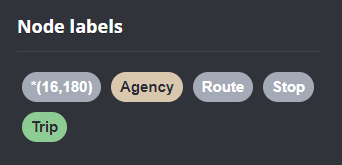
Finally, it’s stop times time. This is where the serious information is. This file is much larger than all previous ones with over 300k lines (i.e. times when an PT vehicle stops).
This requires another tweak to Bert’s script since
using periodic commitis not supported anymore:The PERIODIC COMMIT query hint is no longer supported. Please use CALL { … } IN TRANSACTIONS instead.So I ended up using the following, based on [https:]] ::auto load csv with headers from 'file:///stop_times.txt' as row CALL { with row match (t:Trip {id: row.trip_id}), (s:Stop {id: row.stop_id}) create (t)<-[:BELONGS_TO]-(st:StopTime { arrivalTime: row.arrival_time, departureTime: row.departure_time, stopSequence: toInteger(row.stop_sequence)})-[:STOPS_AT]->(s) } IN TRANSACTIONS OF 10 ROWS;… Added 351388 labels, created 351388 nodes, set 1054164 properties, created 702776 relationships, completed after 1364220 ms.
As you can see, this took a while. But now we have all nodes in place:


The final statement adds additional relationships between consecutive stop times:
call apoc.periodic.iterate('match (t:Trip) return t', 'match (t)<-[:BELONGS_TO]-(st) with st order by st.stopSequence asc with collect(st) as stops unwind range(0, size(stops)-2) as i with stops[i] as curr, stops[i+1] as next merge (curr)-[:NEXT_STOP]->(next)', {batchmode: "BATCH", parallel:true, parallel:true, batchSize:1});This fails with:
There is no procedure with the name apoc.periodic.iterate registered for this database instance. Please ensure you've spelled the procedure name correctly and that the procedure is properly deployed.So, let’s install APOC. That’s a plugin which we can install into our database from within Neo4J Desktop:

After restarting the db, we can run the query:

No errors. Sounds good.
Let’s have a look at what we ended up with. Here are 25 random Trips. I expanded one of them to show its associated StopTimes. We can see the relations between consecutive StopTimes and I’ve expanded the final five StopTimes to show their linked Stops:

I also wanted to visualize the stops on a map. And there used to be a neat app called Neomap which can be installed easily:

However, Neomap does not seem to be compatible with the latest Neo4J:

So this final step will have to wait for another time.
-
sur gvSIG Team: Taller gratuito sobre “Introducción a gvSIG”, con la versión 2.6 y su nuevo juego de iconos en las 19as Jornadas gvSIG
Publié: 27 November 2023, 6:49pm CET
El día 30 de noviembre de 2023, durante las 19as Jornadas Internacionales gvSIG, se realizará un taller gratuito sobre el manejo de la versión 2.6 de gvSIG, con el nuevo juego de iconos.
Para seguir el taller solo deberás registrarte desde el siguiente enlace: Inscripción taller.
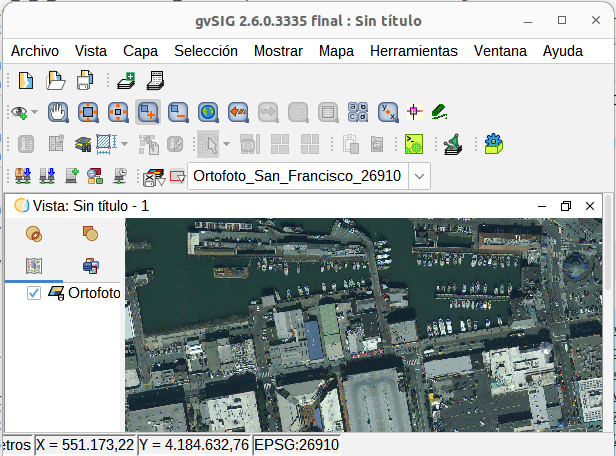
La versión 2.6 incluye por defecto un nuevo juego de iconos mejorado, sustituyendo al que llevaba desde sus versiones iniciales.
En este taller se repasarán las principales herramientas de la aplicación, aprendiendo a crear vistas, cargar capas vectoriales y raster, locales y remotas, a editarlas, tanto gráfica como alfanuméricamente, a aplicar geoprocesamiento y a generar mapas. Todo ello se realizará con el nuevo juego de iconos, que da una versión renovada a gvSIG.
Tanto si ya has utilizado gvSIG previamente, como si es tu primera vez, no puedes perderte este taller.
Para poder seguirlo, deberás descargarte la versión 2.6 portable de gvSIG, según tu sistema operativo: Windows 64 – Windows 32 – Linux 64 – Linux 32
Se deberá descomprimir en una carpeta sin espacios ni acentos ni eñes. Se puede crear por ejemplo una carpeta “gvSIG” en C:\ (en Windows) o en el home de usuario (en Linux), dejar el zip dentro, y descomprimir ahí.
Se deberá también descargar la cartografía a utilizar: Cartografía taller “Introducción a gvSIG 2.6”
-
sur The World as 1000 People
Publié: 27 November 2023, 9:20am CET par Keir Clarke
If the world's population was proportionally represented as 1,000 people then 591 of those people would live in Asia, 185 would live in Africa, 91 in Europe, 75 would live in North America, 55 in South America and the remaining 5 people would live in Oceania. The Visual Capitalist has mapped The World's Population as 1,000 People. On the map each marker (shaped as a human figure)
-
sur GeoServer Team: GeoServer 2.24.1 Release
Publié: 27 November 2023, 1:00am CET
GeoServer 2.24.1 release is now available with downloads (bin, war, windows), along with docs and extensions.
This is a stable release of GeoServer recommended for production use. GeoServer 2.24.1 is made in conjunction with GeoTools 30.1, and GeoWebCache 1.24.1.
Thanks to Jody Garnett (GeoCat) for making this release.
Release notesImprovement:
- GEOS-11152 Improve handling special characters in the Simple SVG Renderer
- GEOS-11153 Improve handling special characters in the WMS OpenLayers Format
- GEOS-11154 Improve handling special characters in the MapML HTML Page
- GEOS-11155 Add the X-Content-Type-Options header
- GEOS-11173 Default to using [HttpOnly] session cookies
- GEOS-11176 Add validation to file wrapper resource paths
- GEOS-11188 Let DownloadProcess handle download requests whose pixel size is larger than integer limits
- GEOS-11189 Add an option to throw a service exception when nearest match “allowed interval” is exceeded
- GEOS-11193 Add an option to throw an exception when the time nearest match does not fall within search limits
Bug:
- GEOS-11074 GeoFence may not load property file at boot
- GEOS-11166 OGC API Maps HTML representation fail without datetime parameter
- GEOS-11184 ncwms module has a compile dependency on gs-web-core test jar
- GEOS-11190 GeoFence: align log4j2 deps
- GEOS-11196 NPE in VectorDownload if ROI not defined
- GEOS-11200 GetFeatureInfo can fail on rendering transformations that generate a different raster
- GEOS-11203 WMS GetFeatureInfo bad WKT exception for label-geometry
- GEOS-11206 Throw nearest match mismatch exceptions only for WMS
For the complete list see 2.24.1 release notes.
Community Module Updates OAuth2 OpenID-Connect improvementsTwo improvements have been made to the community module for OAuth2 OpenID-Connect authentication:
- GEOS-11209 Open ID Connect Proof Key of Code Exchange (PKCE)
- GEOS-11212 ODIC accessToken verification using only JWKs URI
In addition the module includes an
OIDC_LOGGINGprofile and updated documentation covering new settings and troubleshooting guidance.Thanks Jody Garnett for these improvements on behalf of GeoBeyond.
note: Over the course of 2024 the OAuth2 plugins will need to be rewritten for spring-framework 6. Interested parties are encouraged to reach out to geoserver-devel email list; ideally we would like to see this functionality implemented and included as part of GeoServer.
About GeoServer 2.24 SeriesAdditional information on GeoServer 2.24 series:
- GeoServer 2.24 User Manual
- State of GeoServer 2.24 (foss4g-na presentation)
- Control remote HTTP requests sent by GeoTools/GeoServer
- Multiple CRS authority support, planetary CRS
- Extensive GeoServer Printing improvements
- Upgraded security policy
Release notes: ( 2.24.1 | 2.24.0 | 2.24-RC )
GeoServer is an Open Source Geospatial Foundation project supported by a mix of volunteer and service provider activity. We reply on sponsorship to fund activities beyond the reach of individual contributors.
-
sur The World's Largest Snow Dome
Publié: 25 November 2023, 10:37am CET par Keir Clarke
This morning I discovered MapTheClouds, which features a whole host of impressive interactive map visuals. I'm sure a lot of the maps featured on MapTheClouds are very useful but as ever I'm drawn to the fun, experimental maps, to the maps that apparently serve no other purpose than they were fun to create and are even more fun to play with.Here are a few links to my personal favorites, but check
-
sur KAN T&IT Blog: Destacada participación de Julia Martinuzzi y Walter Shilman en el Side Event de UN-GGIM Américas
Publié: 24 November 2023, 6:47pm CET
El pasado 20 de octubre, nuestra Directora de Operaciones (COO), Julia Martinuzzi, y nuestro Director de Tecnología (CTO), Walter Shilman, asumieron roles clave durante la Décima Sesión de la Comisión de las Naciones Unidas para América Latina y el Caribe (ECLAC) celebrada en Santiago de Chile. Su destacada participación se centró en la organización y liderazgo del Side Event titulado «Open Source technologies for geospatial information management and their role in the implementation of the IGIF.»
Este evento, coordinado por el capítulo argentino de OSGeo – Geolibres, reunió a destacados expertos de la región para compartir sus conocimientos sobre enfoques sostenibles y accesibles para abordar los desafíos geoespaciales.
La discusión se centró esencialmente en la implementación del Marco Integrado de Información Geoespacial (IGIF), resaltandola importancia de la accesibilidad y sostenibilidad, con un énfasis primordial en la aplicación de tecnologías de código abierto.
Los participantes exploraron temas clave, como la integración de datos estadísticos y geoespaciales, destacando cómo las tecnologías de código abierto fomentan la colaboración y mejoran la toma de decisiones. Además, se examinó el papel esencial de la geoinformación y las tecnologías de código abierto en la gestión de desastres.
El evento concluyó resaltando la necesidad de difundir y promover el uso de tecnologías de código abierto entre los países miembros de UN-GGIM, subrayando su poder en la Gestión de Información Geoespacial. La colaboración e intercambio de conocimientos entre expertos y principiantes fueron identificados como impulsores clave para un uso más efectivo de la información geoespacial en diversas aplicaciones, desde la planificación urbana hasta la gestión de desastres.
En ese momento, Julia Martinuzzi y Walter Shilman lideraron de manera destacada, contribuyendo significativamente al buen desarrollo del evento. Esperamos que esta experiencia positiva siga siendo una fuente de nuevas ideas y trabajo conjunto en el manejo de información geoespacial en América Latina y el Caribe.

Presentación en el Side Event sobre «Open Source technologies for geospatial information management and their role in the implementation of the IGIF,»
Les compartimos la presentación del evento para que todos puedan acceder.
Presentación Side Event: «Open Source technologies for geospatial information management and their role in the implementation of the IGIF»
UN-GGIM-Americas-Side-Event-ENDescarga
-
sur Global Sentiment Towards Israel & Palestine
Publié: 24 November 2023, 9:30am CET par Keir Clarke
The interactive map Israel-Palestine Media Bias visualizes the results of a sentiment analysis of mostly English language media and social media websites to determine whether they have a predominately Israeli or Palestinian bias.Using the map you can explore the Israel/Palestine sentiment bias expressed by the media in individual countries, on different platforms and by the percentage of a
-
sur SIG Libre Uruguay: Un nuevo reconocimiento a gvSIG
Publié: 23 November 2023, 3:05pm CET
-
sur OGC Compliance Certification now available for the GeoPose 1.0 Data Exchange Standard
Publié: 23 November 2023, 3:00pm CET par Simon Chester
The Open Geospatial Consortium (OGC) is excited to announce that the Executable Test Suite (ETS) for version 1.0 of the OGC GeoPose Data Exchange Standard has been approved by the OGC Membership. Products that implement OGC GeoPose 1.0 and pass the tests in the ETS can now be certified as OGC Compliant.
The OGC Compliance Program offers a certification process that ensures organizations’ solutions are compliant with OGC Standards. It is a universal credential that allows agencies, industry, and academia to better integrate their solutions. OGC Compliance provides confidence that a product will seamlessly integrate with other compliant solutions regardless of the vendor that created them.
Implementers of the GeoPose 1.0 Data Exchange Standard are invited to validate their products using the new test suite in the OGC validator tool. Testing involves submitting an OGC GeoPose 1.0 document produced by the product being assessed. These tests typically take only 5-10 minutes to complete. Once a product has passed the test, the implementer can apply to use the ‘OGC Compliant’ trademark on their product.
OGC GeoPose is a free and open Implementation Standard for exchanging the location and orientation of real or virtual geometric objects (“Poses”) within reference frames anchored to Earth’s surface (“Geo”) or within other astronomical coordinate systems. The Standard specifies a JavaScript Object Notation (JSON) encoding for representing conformant poses.
The GeoPose Standard specifies a number of conformance classes, most being optional. One conformance class is defined for each corresponding set of Structural Data Units (SDUs), where each SDU is linked to the Logical Model as an alias for a class or attribute. The following conformance classes from the OGC GeoPose 1.0 Data Exchange Standard (OGC 21-056r11) are supported by the ETS:
- Basic-YPR (Yaw-Pitch-Roll) SDU JSON
- Basic-Quaternion SDU JSON – Permissive
- Advanced SDU JSON
- Graph SDU JSON
- Chain SDU JSON
- Regular Series SDU JSON
- Stream SDU JSON
Some of the products implementing the GeoPose Standard that have already been certified as OGC Compliant include Away Team Software’s 3D Compass 1, OpenSitePlan’s SolarPose 1.0, and Ethar Inc.’s GeoPose C# Library 1.0. These products apply GeoPose in a wide variety of applications, such as Augmented Reality (AR), mobile Location Based Services (LBS), web APIs, and more. To implement GeoPose in your product, please refer to the OGC GeoPose 1.0 Data Exchange Standard document, freely available from OGC. Additional documentation is also available on the GeoPose website.
More information about the OGC compliance process, and how it can benefit your organization, is available at ogc.org/compliance. Implementers of the OGC GeoPose 1.0 Data Exchange Standard – or other OGC Standards – can validate their products now using the OGC Validator Tool.
The post OGC Compliance Certification now available for the GeoPose 1.0 Data Exchange Standard appeared first on Open Geospatial Consortium.
-
sur gvSIG Team: El Proyecto GVSIG, impulsado por la Generalitat Valenciana y la Asociación GVSIG, galardonado como mejor proyecto de software de Europa en los OSOR Awards
Publié: 23 November 2023, 11:25am CET

El Proyecto GVSIG, una iniciativa conjunta de la Generalitat Valenciana y la Asociación GVSIG, ha sido distinguido con el primer premio en los OSOR Awards. Este galardón reconoce los logros excepcionales que ha logrado el proyecto GVSIG a nivel internacional y reflejan el compromiso continuo de la Generalitat Valenciana con la innovación y la colaboración.
Los OSOR Awards han sido organizados por el Observatorio de Software Libre (OSOR) de la Comisión Europea con motivo de su 15 aniversario, y han querido destacar los mejores proyectos impulsados por las administraciones públicas de toda Europa. En este contexto, GVSIG ha destacado entre todas las nominaciones, convirtiéndose en el ganador de los premios, en los que se ha destacado su impacto global y su contribución al desarrollo tecnológico europeo.
Según los organizadores de los premios se recibieron más de cien candidaturas de 23 países. Tras una primera fase, el jurado seleccionó los seis mejores proyectos, donde GVSIG compartía opciones con proyectos de España, Dinamarca, Italia y Francia. Durante el evento organizado en el día de ayer en Bruselas, los seis proyectos tuvieron que defender su candidatura ante el jurado de la Comisión Europea. Finalmente fue anunciado el ganador: el proyecto GVSIG presentado conjuntamente por la Generalitat Valenciana y la Asociación GVSIG.El Proyecto GVSIG es un catálogo de herramientas informáticas para gestión de información geográfica que desde su nacimiento en 2004 ha ido ganado reconocimiento por su versatilidad y utilidad en una variedad de sectores, desde la gestión de recursos naturales hasta la planificación urbana. La Generalitat Valenciana ha desempeñado un papel fundamental tanto en su impulso inicial como en el respaldo continuo al proyecto. La Asociación GVSIG, por su parte, ha desempeñado un papel esencial en la promoción y difusión de esta plataforma a nivel internacional, facilitando la generación y crecimiento de un sector empresarial valenciano especialista en tecnologías de información geográfica. Un ejemplo de colaboración público-privada que ahora obtiene el reconocimiento de Europa.
Este prestigioso galardón no solo reconoce el éxito del Proyecto GVSIG, sino que también destaca el compromiso de la Generalitat Valenciana y la Asociación GVSIG con la promoción de soluciones tecnológicas abiertas y accesibles, fomentando la innovación y la colaboración como motor de desarrollo.
GVSIG da solución a todas las necesidades relacionadas con la geolocalización y la administración del territorio. En la Generalitat Valenciana se multiplican sus usuarios y entre los diversos ejemplos de uso se encuentran desde aplicaciones para ayudar a proteger las praderas fanerógamas, la conocida posidonia, evitando fondear en zonas protegidas a aplicaciones de gestión del registro vitivinícola, pasando por soluciones para fomentar la movilidad sostenible mediante un planificador de rutas más versátil que el propio Google Maps o aplicaciones para analizar los accidentes de tráfico.
Si su uso es transversal en la Generalitat Valenciana, otro tanto ocurre a nivel global. Son innumerables las entidades de todo tipo que utilizan esta tecnología valenciana. En la presentación de los OSOR Awars se citaron varias de ellas. A nivel supranacional entidades como Naciones Unidas la han adoptado como tecnología de referencia en usos tan destacados como facilitar la seguridad de las misiones de los Cascos Azules en sus desplazamientos ante ataques terroristas. A nivel nacional ha sido igualmente adoptada, contando casos tan significativos como el del Gobierno de Uruguay, donde GVSIG es la base tecnológica para todos los proyectos de gestión y difusión de información territorial del país, habiendo servido también para crear un sistema único de direcciones. En Uruguay ha sido tal el nivel de adopción que en la educación secundaria es utilizada para el aprendizaje de las materias relacionadas con la geografía. Su uso a nivel regional y local nos lleva a citar ejemplos como el del Estado de Tocantins en Brasil, donde se ha convertido en la plataforma de gestión geográfica y estadística o el Gobierno de Córdoba en Argentina, donde es utilizada para analizar los datos de criminalidad y seguridad ciudadana. Y donde todavía está más implantada es en las administraciones locales, donde GVSIG está siendo adoptada a gran velocidad por decenas de ayuntamientos de toda España; los últimos han sido los Ayuntamientos de Alicante, Albacete, Cartagena y Talavera de la Reina. Solo en la Comunidad Valenciana el número de ayuntamientos que confían en GVSIG es innumerable: Cullera, Onda, Picassent, L’Eliana, La Pobla de Vallbona, Nàquera, Alzira, Benicarló… e igualmente otras entidades valencianas han adoptado GVSIG como el Consorcio Provincial de Bomberos de Valencia, donde su uso se centra en la gestión de emergencias. Y más allá de la administración pública, cuya relación con el territorio es directa, GVSIG también ha entrado a formar parte de las soluciones informáticas que utilizan empresas que trabajan con información geoposicionada, como es el caso de Repsol que hace un uso extensivo de GVSIG en su división de energías renovables.
El premio otorgado a la Generalitat Valenciana y a la Asociación GVSIG se suma a otros galardones obtenidos anteriormente, de entidades tan diversas como el Diario Expansión o la NASA.
GVSIG es un referente en lo que se ha denominado Infraestructuras de Datos Espaciales, la puesta en marcha de plataformas que permitan a las administraciones públicas compartir su información geográfica mediante estándares.
El impacto del proyecto tiene numerosas derivadas, a nivel académico se imparte formación en GVSIG en universidades de todo el mundo, se publican anualmente cientos de artículos científicos donde se utiliza GVSIG como herramienta de los investigadores, se multiplican las conferencias y eventos donde se presentan todo tipo de proyectos desarrollados con GVSIG.
GVSIG, un proyecto basado en el conocimiento libre, ejemplo de colaboración público-privada que sitúa a Valencia como uno de los indiscutibles polos de referencia en el ámbito de la geomática, la tecnología aplicada a la dimensión geográfica de la información. El premio obtenido ayer es un reconocimiento a todo el camino recorrido.
Recientemente ha sido nominado al Premio Nacional de Ciencias Geográficas, todavía por resolver. Lo que nos han confirmado fuentes de la Asociación gvSIG es que esta candidatura ha recibido más de 150 cartas de apoyo de entidades de todo el mundo, desde el Departamento de Transporte de Washington al Ordnance Survey, la agencia cartográfica del Reino Unido. -
sur gvSIG Team: The GVSIG Project, driven by the Generalitat Valenciana and the GVSIG Association, awarded as the best software project in Europe at the OSOR Awards
Publié: 23 November 2023, 9:24am CET

The GVSIG Project, a joint initiative of the Generalitat Valenciana and the GVSIG Association, has been honored with the first prize at the OSOR Awards. This award recognizes the exceptional achievements of the GVSIG project on an international level and reflects the ongoing commitment of the Generalitat Valenciana to innovation and collaboration.
The OSOR Awards were organized by the Observatory of Open Source Software (OSOR) of the European Commission on the occasion of its 15th anniversary, aiming to highlight the best projects driven by public administrations throughout Europe. In this context, GVSIG stood out among all nominations, becoming the winner of the awards, emphasizing its global impact and contribution to European technological development.
According to the award organizers, over a hundred nominations from 23 countries were received. After an initial phase, the jury selected the top six projects, where GVSIG competed alongside projects from Spain, Denmark, Italy, and France. During the event held yesterday in Brussels, the six projects had to defend their candidacy before the European Commission’s jury. Finally, the winner was announced: the GVSIG project jointly presented by the Generalitat Valenciana and the GVSIG Association.
The GVSIG Project is a catalog of computer tools for geographic information management that, since its inception in 2004, has gained recognition for its versatility and usefulness in various sectors, from natural resource management to urban planning. The Generalitat Valenciana has played a fundamental role in both its initial promotion and continuous support for the project. The GVSIG Association, in turn, has played an essential role in promoting and disseminating this platform internationally, facilitating the generation and growth of a Valencian business sector specializing in geographic information technologies. An example of public-private collaboration that now receives recognition from Europe.
This prestigious award not only acknowledges the success of the GVSIG Project but also highlights the commitment of the Generalitat Valenciana and the GVSIG Association to promoting open and accessible technological solutions, fostering innovation and collaboration as drivers of development.
GVSIG addresses all needs related to geolocation and territory management. Its users in the Generalitat Valenciana are multiplying, and among various use cases are applications to help protect seagrass meadows, such as the well-known posidonia, by avoiding anchoring in protected areas, applications for managing the vineyard registry, and solutions to promote sustainable mobility through a route planner more versatile than Google Maps itself, or applications to analyze traffic accidents.
If its use is widespread in the Generalitat Valenciana, the same is true globally. Countless entities of all kinds use this Valencian technology. Several were mentioned in the presentation of the OSOR Awards. At the supranational level, entities like the United Nations have adopted it as a reference technology for prominent uses, such as enhancing the security of Blue Helmets’ missions during their travels in the face of terrorist attacks. Nationally, it has been similarly adopted, with significant cases such as the Government of Uruguay, where GVSIG is the technological basis for all territorial information management and dissemination projects in the country, also serving to create a unique addressing system. In Uruguay, its adoption is so extensive that it is used in secondary education for learning subjects related to geography. Its use at the regional and local levels leads to examples such as the State of Tocantins in Brazil, where it has become the platform for geographic and statistical management, or the Government of Córdoba in Argentina, where it is used to analyze crime and public safety data. It is even more deeply entrenched in local administrations, with GVSIG being rapidly adopted by dozens of municipalities throughout Spain, including the recent additions of the municipalities of Alicante, Albacete, Cartagena, and Talavera de la Reina. In the Valencian Community alone, the number of municipalities trusting GVSIG is countless: Cullera, Onda, Picassent, L’Eliana, La Pobla de Vallbona, Nàquera, Alzira, Benicarló, and many other Valencian entities have also adopted GVSIG, such as the Provincial Fire Consortium of Valencia, where its use focuses on emergency management. Beyond the public administration, whose relationship with the territory is direct, GVSIG has also become part of the computer solutions used by companies working with geopositioned information, such as Repsol, which extensively uses GVSIG in its renewable energy division.
The award granted to the Generalitat Valenciana and the GVSIG Association adds to other accolades previously obtained from diverse entities such as Diario Expansión or NASA.
GVSIG is a reference in what is called Spatial Data Infrastructures, the implementation of platforms that allow public administrations to share their geographic information through standards.
The impact of the project has numerous ramifications; academically, GVSIG training is offered at universities worldwide, hundreds of scientific articles are published annually using GVSIG as a tool by researchers, and conferences and events showcasing various projects developed with GVSIG abound.
GVSIG, a project based on free knowledge, is an example of public-private collaboration that positions Valencia as one of the undisputed reference hubs in the field of geomatics, technology applied to the geographic dimension of information. The award obtained yesterday is recognition for the entire journey taken.
Recently, it has been nominated for the National Geographic Sciences Award, still pending resolution. Sources from the GVSIG Association have confirmed that this candidacy has received more than 150 letters of support from entities worldwide, from the Department of Transportation in Washington to the Ordnance Survey, the cartographic agency of the United Kingdom.
-
sur America is a Jigsaw
Publié: 23 November 2023, 8:22am CET par Keir Clarke
If you want a little Thanksgiving fun today then you should play TripGeo's State Locator game. State Locator is an interactive map of the United States. A map which you have to assemble yourself based on the shapes of the individual states and a few image clues.At the beginning of the game you are presented with a random state. Your job is to place this state onto a blank map of the United
-
sur gvSIG Team: Program of 19th International gvSIG Conference (online) is now available, and registration (free of charge) period is open
Publié: 22 November 2023, 10:18am CET
Free registration period for the 19th International gvSIG Conference is now open. The Conference is an online event, and it will be held from November 29th to 30th.
The full program of the Conference is available on the event website, where registration to the different sessions can be done.

The webinar platform allows to connect to the webinars from any operating system, and in case you can’t follow them, you will be able to watch them at the gvSIG Youtube channel later.
In reference to workshops, all the information about cartography and gvSIG version to install will be published at the gvSIG blog before the conference.
Don’t miss it!
-
sur gvSIG Team: Programa e inscripciones gratuitas abiertas para las 19as Jornadas Internacionales gvSIG (online)
Publié: 22 November 2023, 10:09am CET
Ya están abiertas las inscripciones gratuitas para las 19as Jornadas Internacionales gvSIG, que se celebrarán de forma online los días 29 y 30 de noviembre.
El programa completo está disponible en la página web del evento, desde donde se puede realizar la inscripción a cada una de las ponencias.

La plataforma de webinar permite conectarse desde cualquier sistema operativo, y en caso de no poder seguirlos en directo se podrán ver a posteriori, ya que se publicarán en el canal de Youtube del proyecto al igual que en años anteriores.Respecto a los talleres, en el blog de gvSIG informaremos sobre la cartografía a descargar para seguirlos, así como de la versión de gvSIG a instalar.
-
sur Where Your Food Comes From
Publié: 22 November 2023, 9:32am CET par Keir Clarke
When you begin to prepare your Thanksgiving dinner you may wonder about where all that food comes from. Well a new interactive map from CU Boulder and The Plotline, can help show you where. The Food Twin shows you where food is grown and consumed in America and how crops travel from producers to consumers.Click on your county on the map and you will see colored dots flowing into your
-
sur SIG Libre Uruguay: Las TIG ante los nuevos retos globales en un contexto cambiante. Actas de la XVIII CONFIBSIG 2023. Cáceres, 16-19 de mayo de 2023
Publié: 21 November 2023, 3:52pm CET
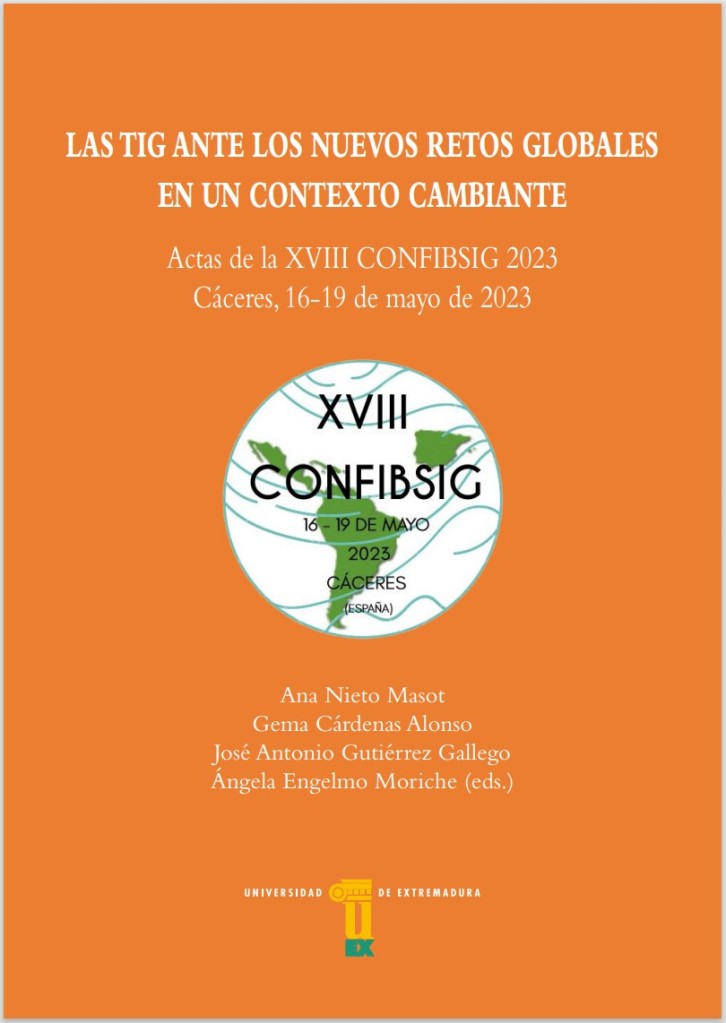
Descarga de la publicación aquí
-
sur America's Changing Plant Hardiness Zones
Publié: 21 November 2023, 7:37am CET par Keir Clarke
Around half of Americans have been moved into a new plant hardiness zone. If you check out the USDA's new Plant Hardiness Zone Map you have a very good chance of discovering that your home is now in a new hardiness zone.In recent years, like many gardeners, I've discovered that I can successfully sow plants a few weeks before their recommended earliest dates and that I can continue


